We’ve spent many posts and recipes on the PIATTO Recipes website explaining that Italians in Italy are very particular about what carries the name ‘Spaghetti Carbonara.’ And in fact, we have both the Spaghetti Carbonara recipe considered traditional today in our collection and the recipe considered by some to be the ‘original’ (historic) Carbonara with Cream and Bacon as well—the so-called WWII Carbonara. And now, we’re going to enter the realm of Italian contradictions by introducing the popular Spaghetti Carbonara di Mare (Seafood Carbonara)!
What is Spaghetti Carbonara di Mare? This dish is a fish or seafood based pasta with the classic egg sauce famous to the Roman Carbonara. It’s most popular in the regions of Lazio, Toscana (Viareggio) and on the Romagnola Rivieria. The idea is to use the fish or shellfish in place of the guanciale—a particularly appealing idea during the Italian Christmas Eve celebration when meat is avoided for religious reasons. Without further ado, let’s dive into our recipe!
This Recipe is In Our Cookbook!
Pasta Affair: 50 Authentic Italian Recipes
Seductive strands of pasta and sumptuous sauces… Are you ready to indulge in an unforgettable Pasta Affair? It’s the best pasta cookbook for beginners and a must-have for any serious lover of Italian food, featuring over 50 classic pasta recipes you can make at home! Print Hardcover or Kindle Ebook!
Watch the Video Recipe!
Carbonara di Mare? Watch our video recipe with Flavia Diamante, filmed in Italy:
Subscribe to our YouTube Channel
More video recipes? Subscribe to our YouTube Channel (it’s FREE) and click the bell to get notifications when we release a new video recipe!
How to Make Seafood Carbonara Spaghetti
The guidelines for making Seafood Carbonara are few and often contradictory. If using fish, the choices are usually salmon, tuna or swordfish (or a mix). If using shellfish, clams, mussels and even a few shrimp are common. Some recipes combine shellfish and fish. Many recipes attempt to still add some kind of cheese to the egg sauce (Parmigiano or pecorino), though we are personally skeptical of this. In Italian cuisine, mixing cheese with fish or seafood is considered odd at best and criminal at worst.
What follows is the PIATTO version of Seafood Carbonara—which we think combines the best of the recipes floating around. Our Spaghetti Carbonara di Mare includes cubes of salmon, tuna and swordfish to mimic the meaty guanciale. For the sauce, we are creating a homemade shellfish broth with steamed mussels and clams and combining that with pasteurized eggs. This melds the rich flavor of Spaghetti with Clams with the creaminess of a Carbonara sauce.
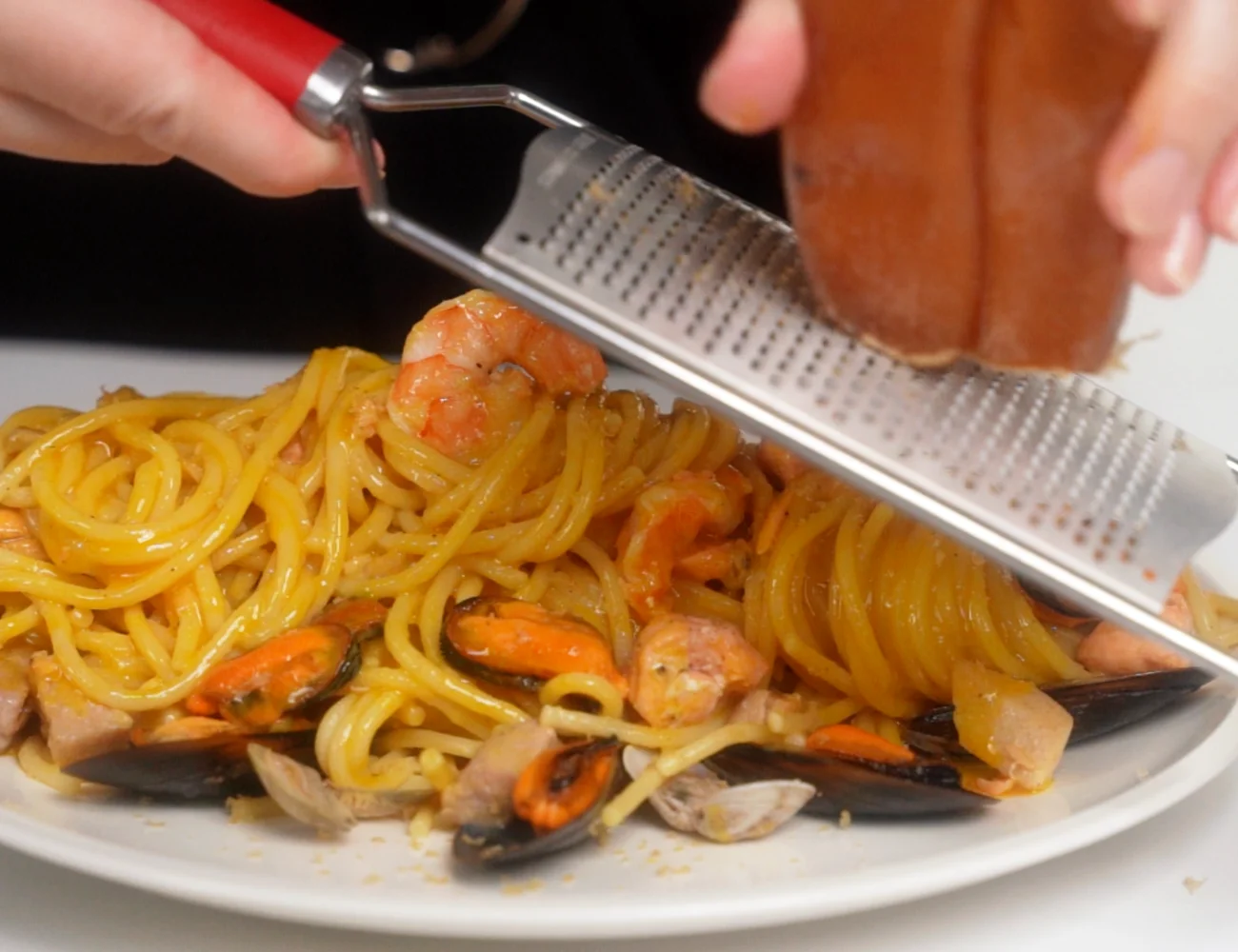
Choose Your Seafood
As we mentioned, you can choose from a wide range of seafood to make this dish. Traditional options include:
- salmon, tuna, swordfish
- and/or mussels and clams.
We are using a bit of everything in ours, and even throwing in a few shrimp at the end!
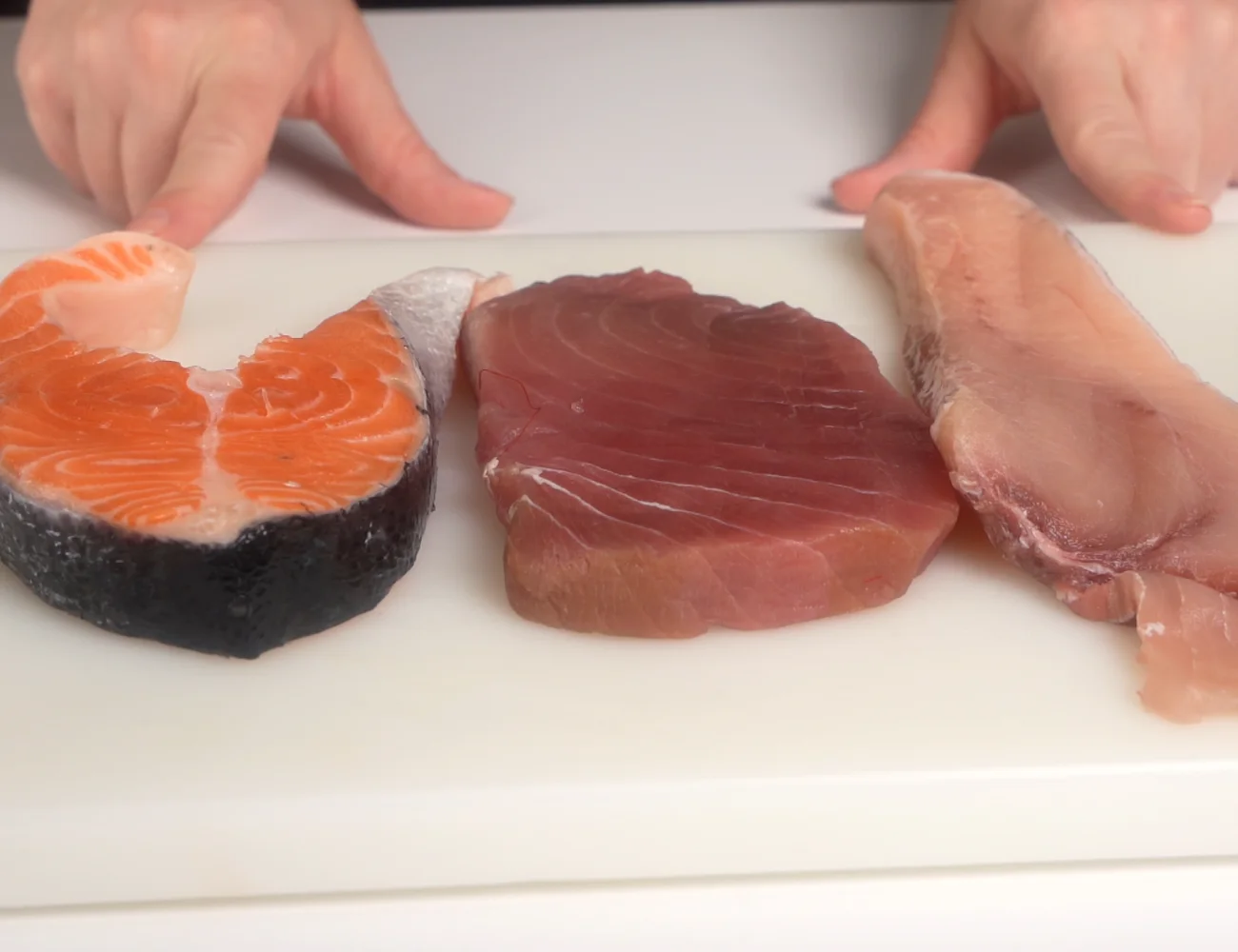
Prep Your Seafood
The fish is easy to prep. Remove the skin of the fish filet (and any bones). Cube or slice the fish into pieces (like guanciale).
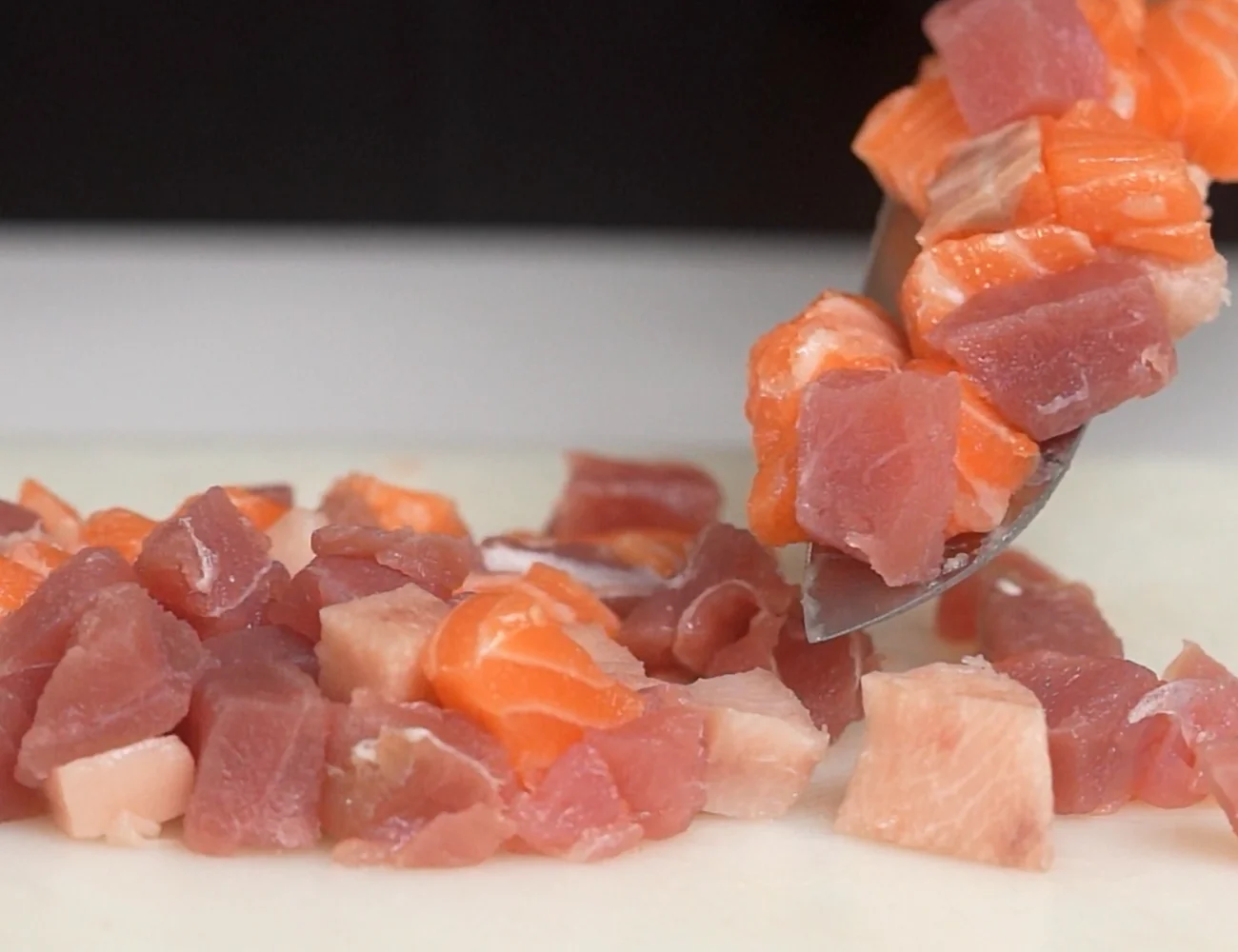
Our recipe for Seafood Carbonara relies on shellfish broth to flavor the egg sauce. To save time, you can buy clam juice (bottled) and shellfish meat frozen. We chose to steam the clams and mussels and use the resulting broth in our pasta! However, if you are working with fresh clams and mussels, a bit of prep is necessary.
Check for Signs of Life
Clams and mussels in the shell should be alive when they are cooked to ensure safety and freshness. The first step is to be sure shellfish are still alive.
- Visible cracks in shell? Discard.
- Is shell open and does not close after you tap it? Discard.
- Rinse the outside of the clams and mussels.
Discard any shellfish that have visible cracks. If the shell of a clam or mussel is open (outside of water), give it a light tap on a bowl or surface. Does the shell immediately close? Then the shellfish is still alive and probably safe to eat.
If the shell does not close after you tap, discard it. These shellfish are not safe to eat. It may sound sadistic, but you need to cook shellfish when they are alive. If the shell is already open out of water, the clam or mussel is likely dead.
Soak the Clams
Unlike mussels, clams tend to be full of sand inside. Yes, theoretically, you can simply steam them and try to filter out the sand after. However, in our experience, it’s very difficult to filter all of the sand out at that stage and sand ruins a delicious seafood pasta!
For this reason, we believe in the school of thought advocating for soaking the clams in salt water to remove the sand before cooking the clams.
How to Soak Clams (2 Hours)
- Prepare a salt water solution for soaking the clams —2 tablespoons (35 g) of fine salt to 4 cups (1 liter) of water.
- Soak the healthy clams in the salted water for at least 2 hours.
- Remove the clams with a slotted spoon—This ensures that the sand that sank to the bottom during the soak remains there.
- Do not strain the water to remove the clams—We don’t want to pour that sand we extracted back over our clams by straining!
During the soak, the clam shells will open and many will poke their little heads out. This is totally normal! They are doing this to exchange the water in their shells with the fresh salt water you’ve provided them. The sand will fall to the bottom of the bowl of water.
To make this easier, sit the clams in a sieve suspending at the top of the bowl of water and then the sand naturally falls to the bottom of the bowl and away from our clams.
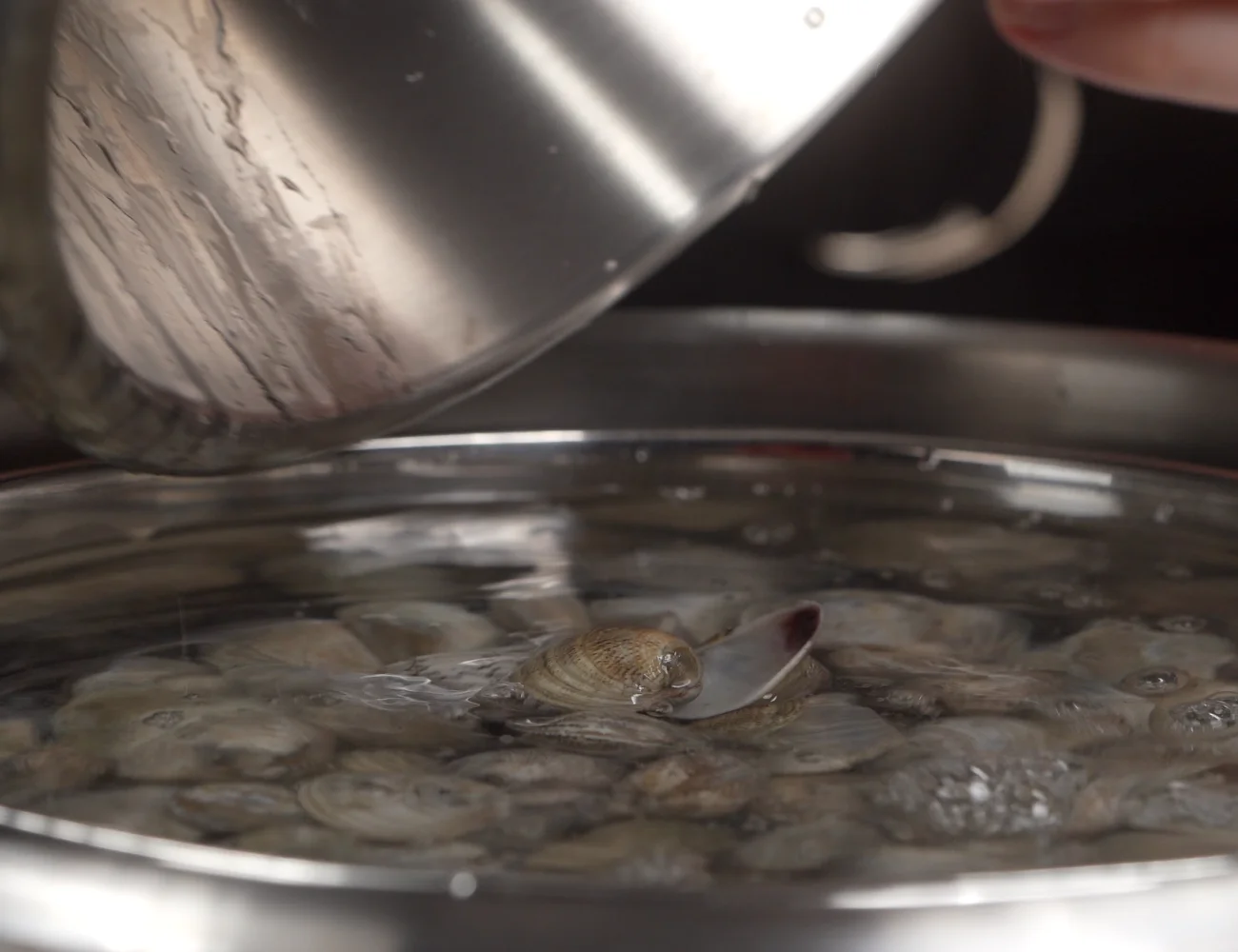
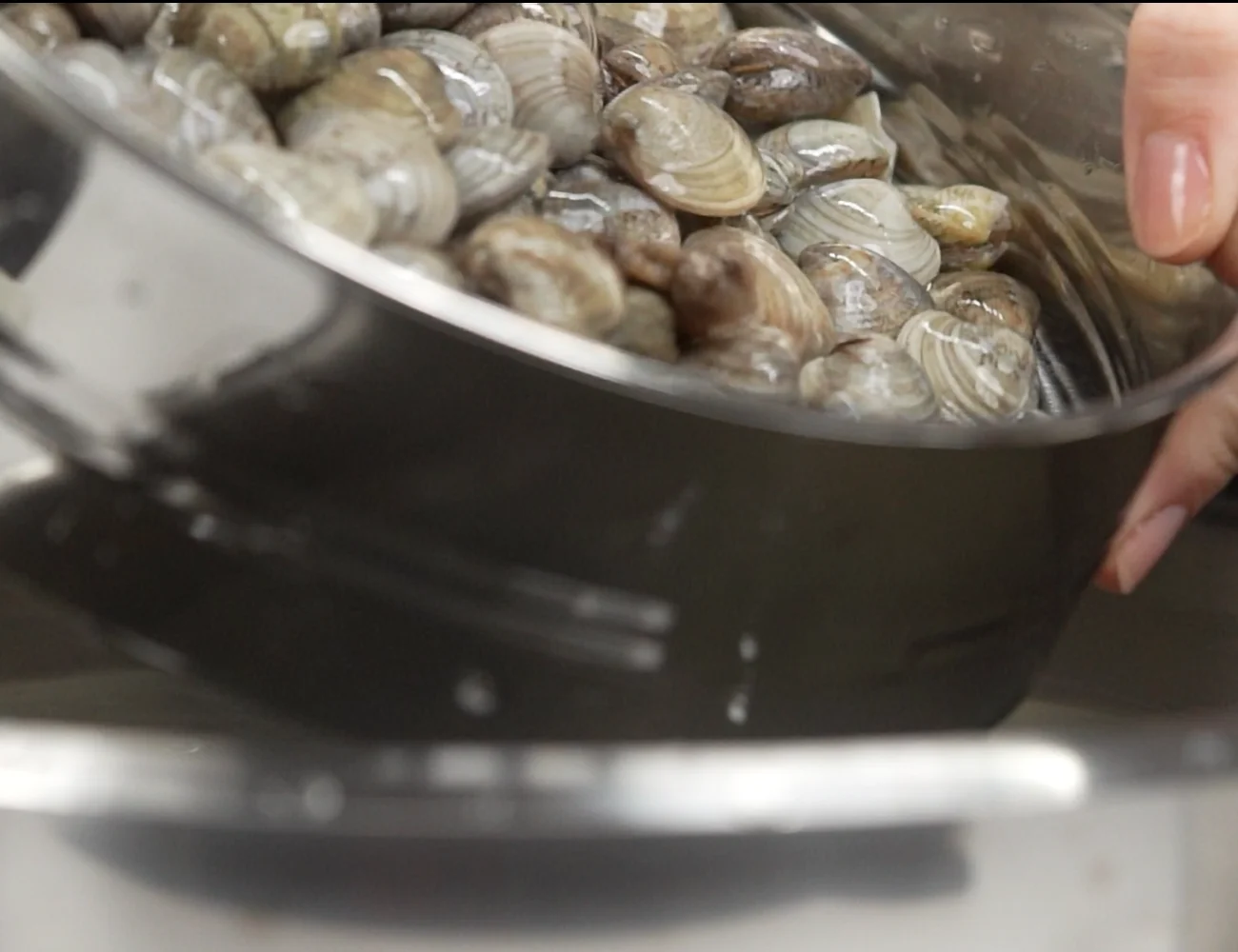
Remove Mussel Beards
Mussel prep is much easier. They don’t tend to carry sand in the shells. After rinsing them on the outside, pull the ‘beard’ off of each mussel.
To remove the beard: Hold each mussel narrow side up. Grab the beard and pull down and away from the narrow side of the mussel until it pops off. Discard all beards.
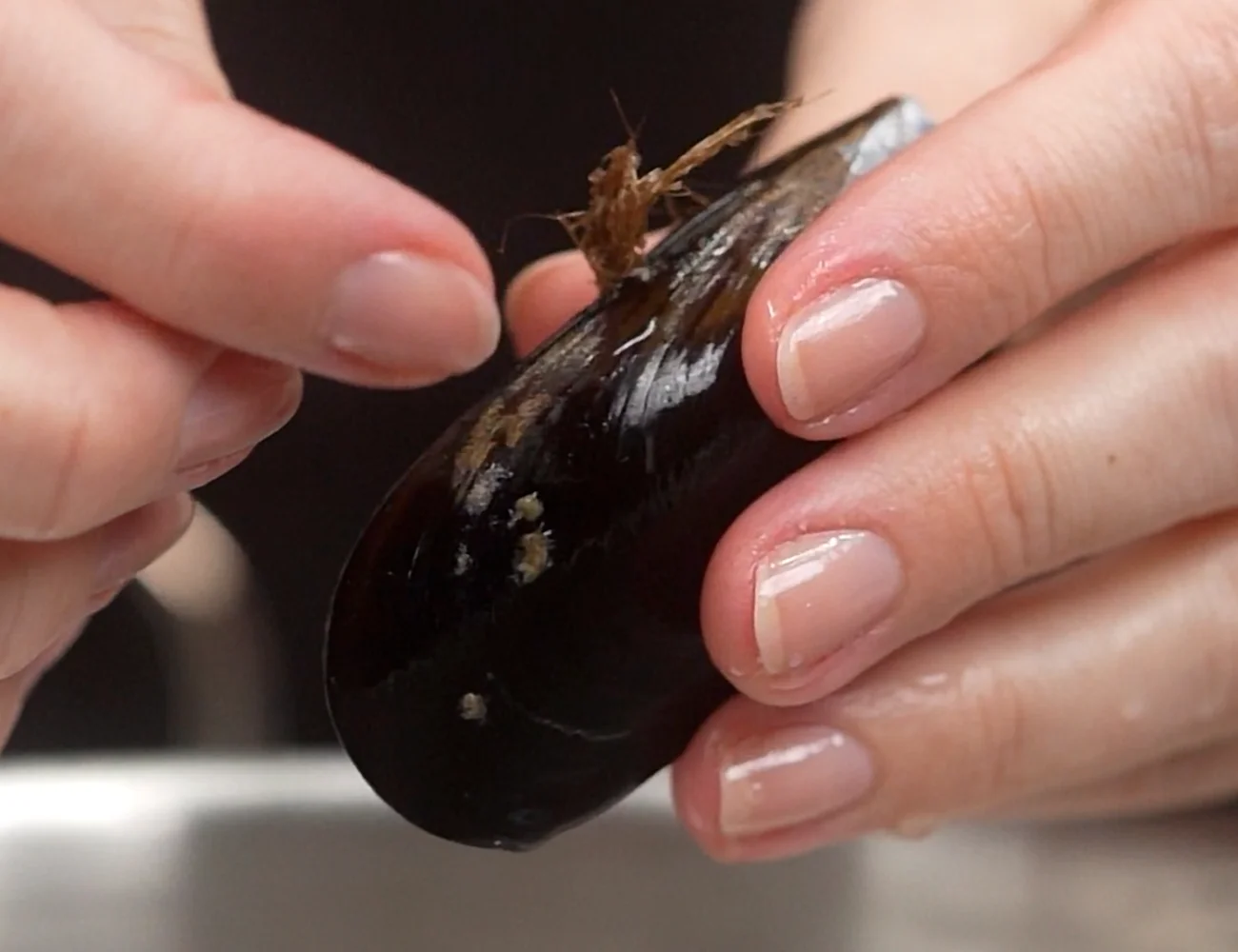
Now our shellfish is ready to steam. We’ll use both the shellfish meat and the broth they produce in our Seafood Carbonara!
How to Make Seafood Carbonara (Spaghetti Carbonara di Mare)
Steam the Shellfish / Strain the Broth
Steaming clams and mussels is very easy and a key step in many classic Italian food recipes.
It usually starts with a bit of olive oil in the bottom of a skillet. Then we create a quick soffritto with garlic and any herbs we want to add. Finally we add the mussels and clams.
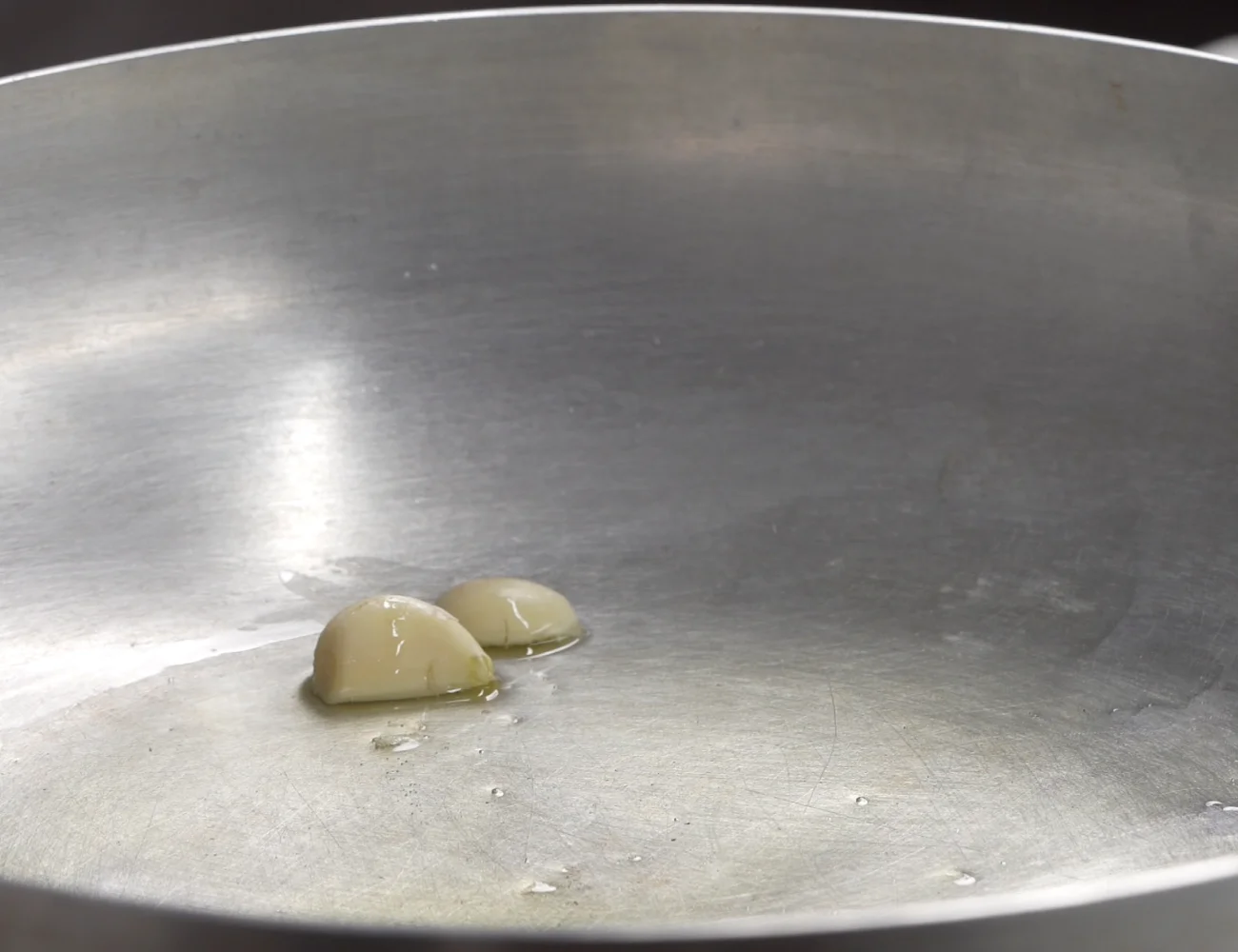
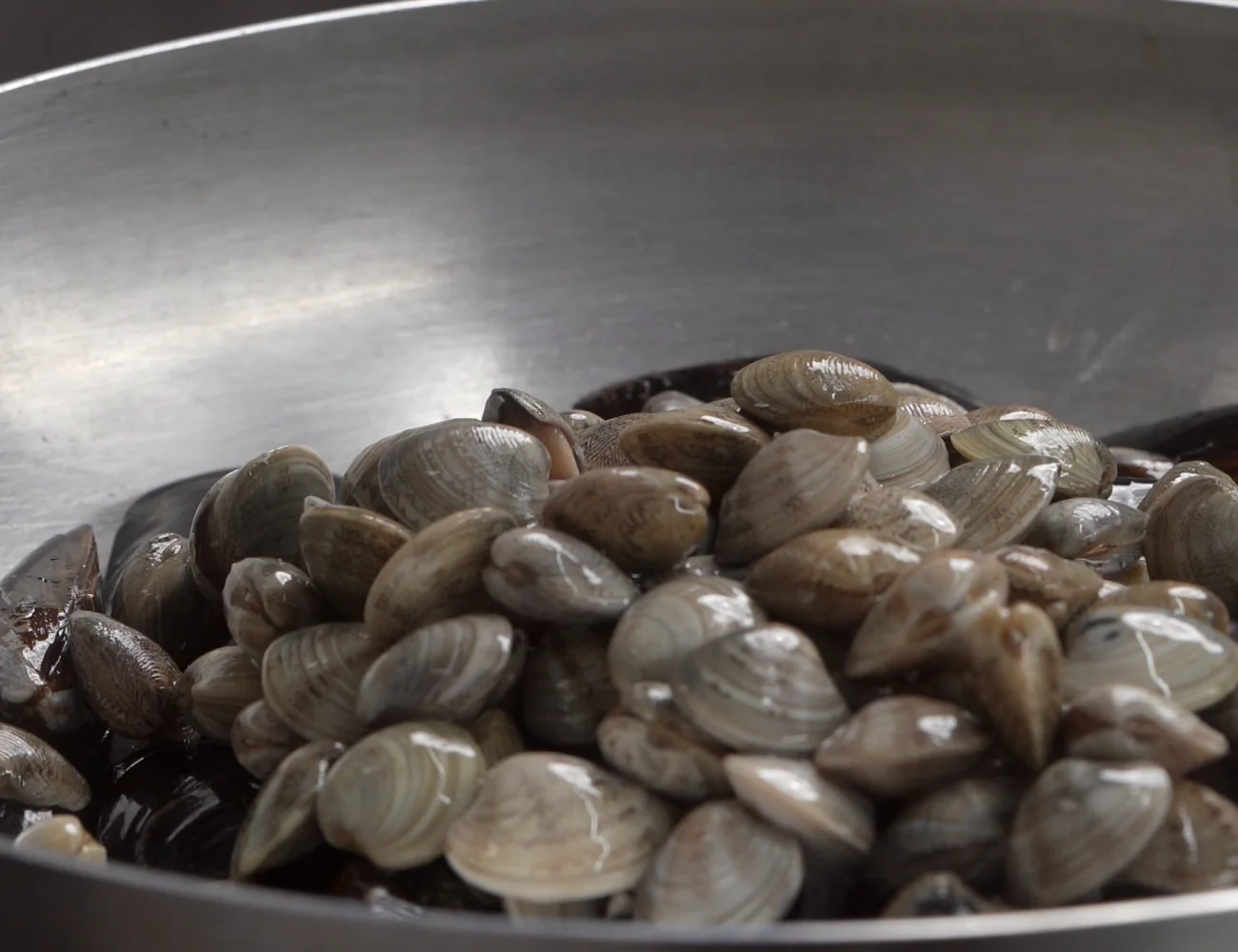
Then, we simply cover the shellfish and cook them over medium heat until all or most shells have opened.
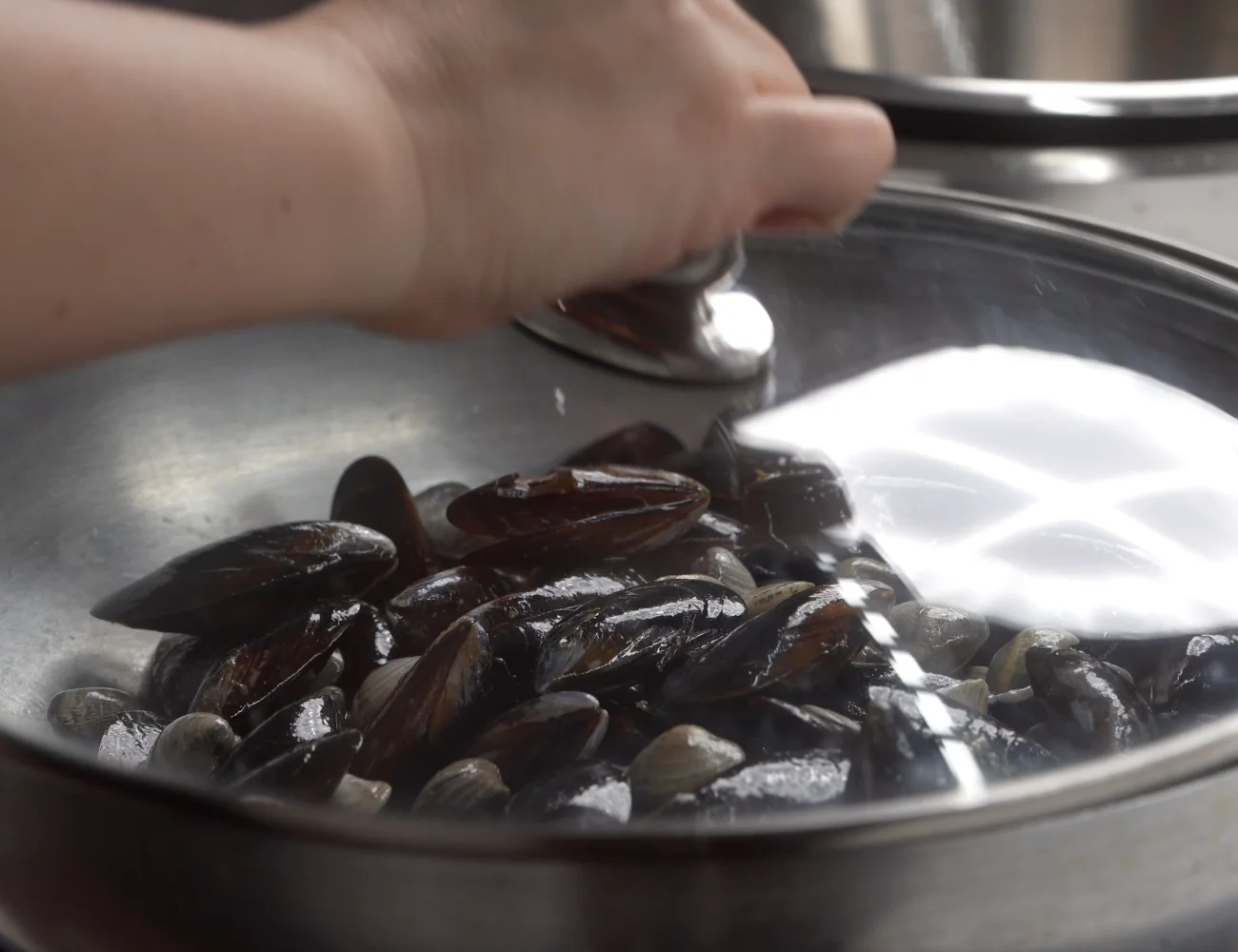
Discard any clams whose shells have not opened after steaming. They aren’t safe to eat.
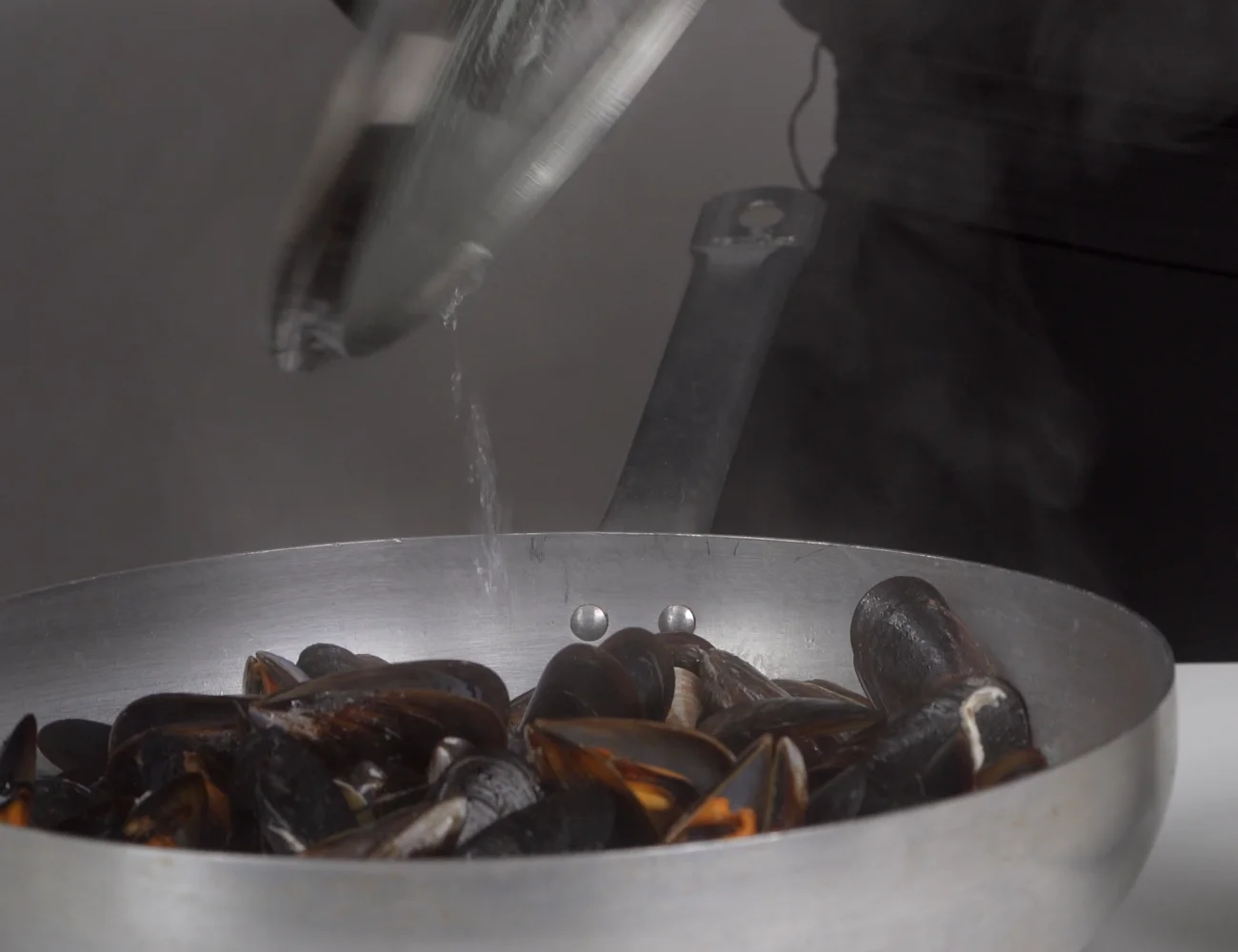
Strain the Broth
Now, we want to remove the shellfish meat from the shells and strain the broth that they produced while steaming. Use a very fine sieve or even a cheesecloth to filter the broth. This will remove any sand that remains.
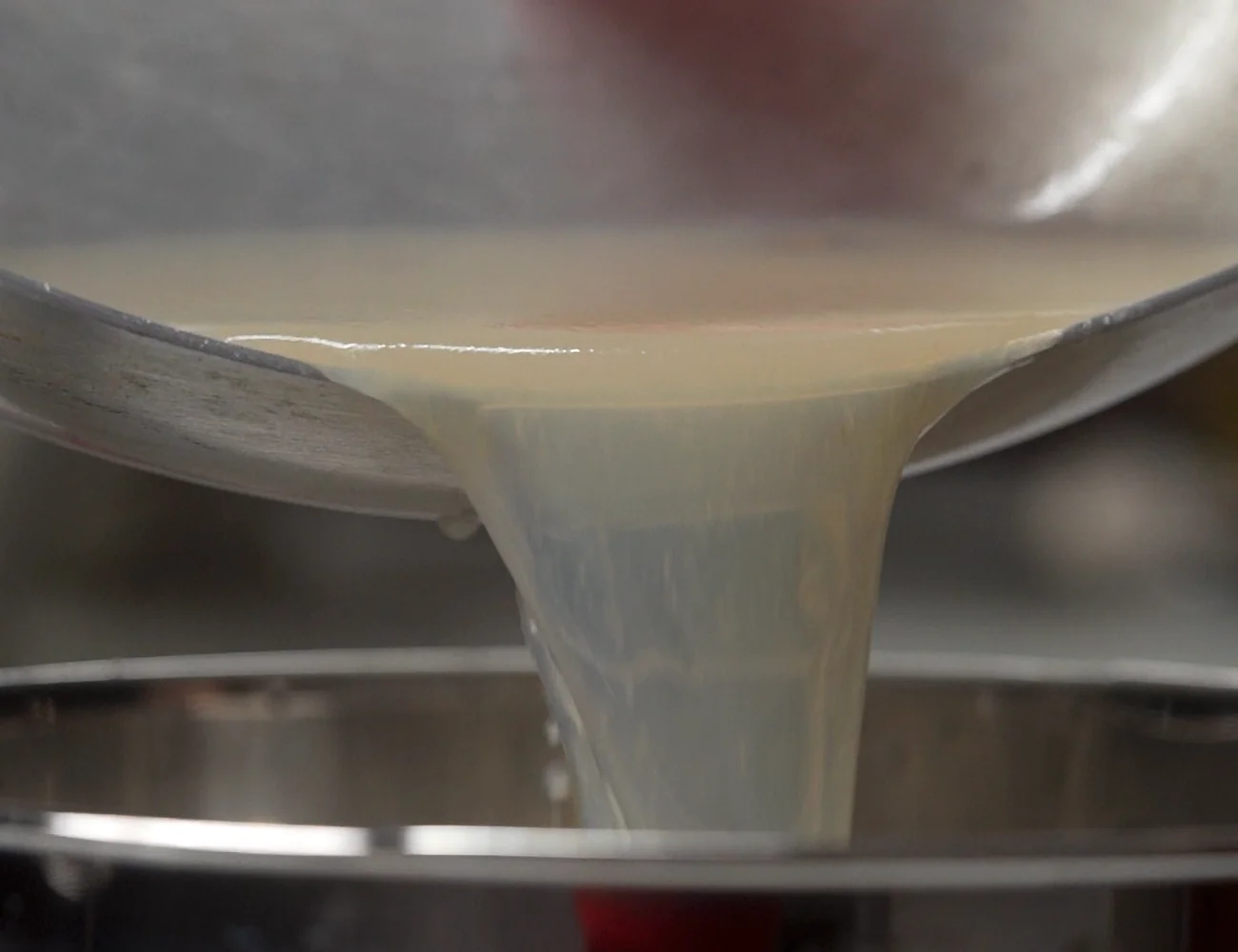
Add the shellfish meat (removed from the shell) to the broth to avoid it trying out until we are ready to use it. We usually leave a few clams and mussels in the shell for plating. This is optional of course.
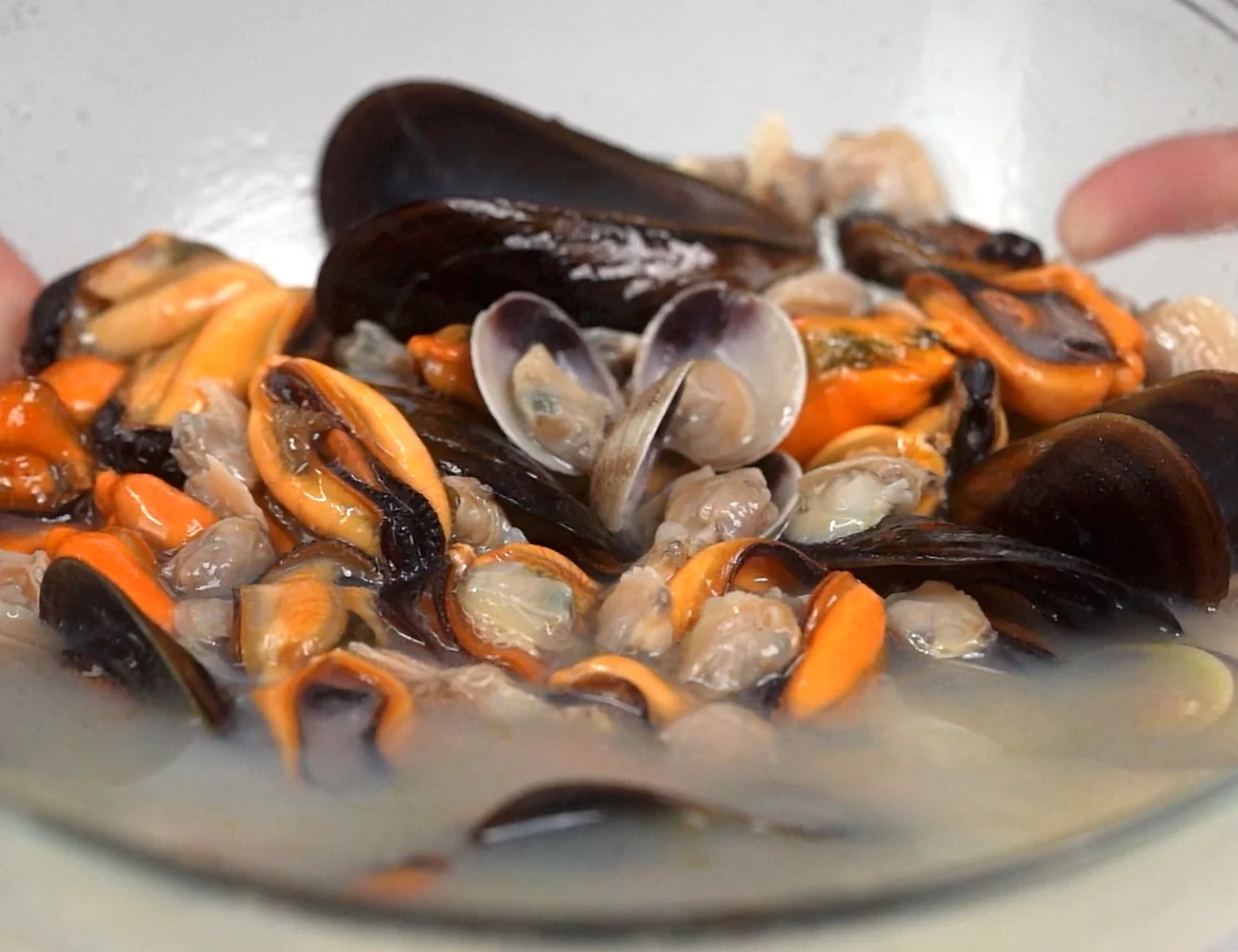
Cook the Fish
Cook the cubed fish in a bit of butter or lard over medium heat until it’s opaque and changes color. Cut fish like this cooks very quickly.
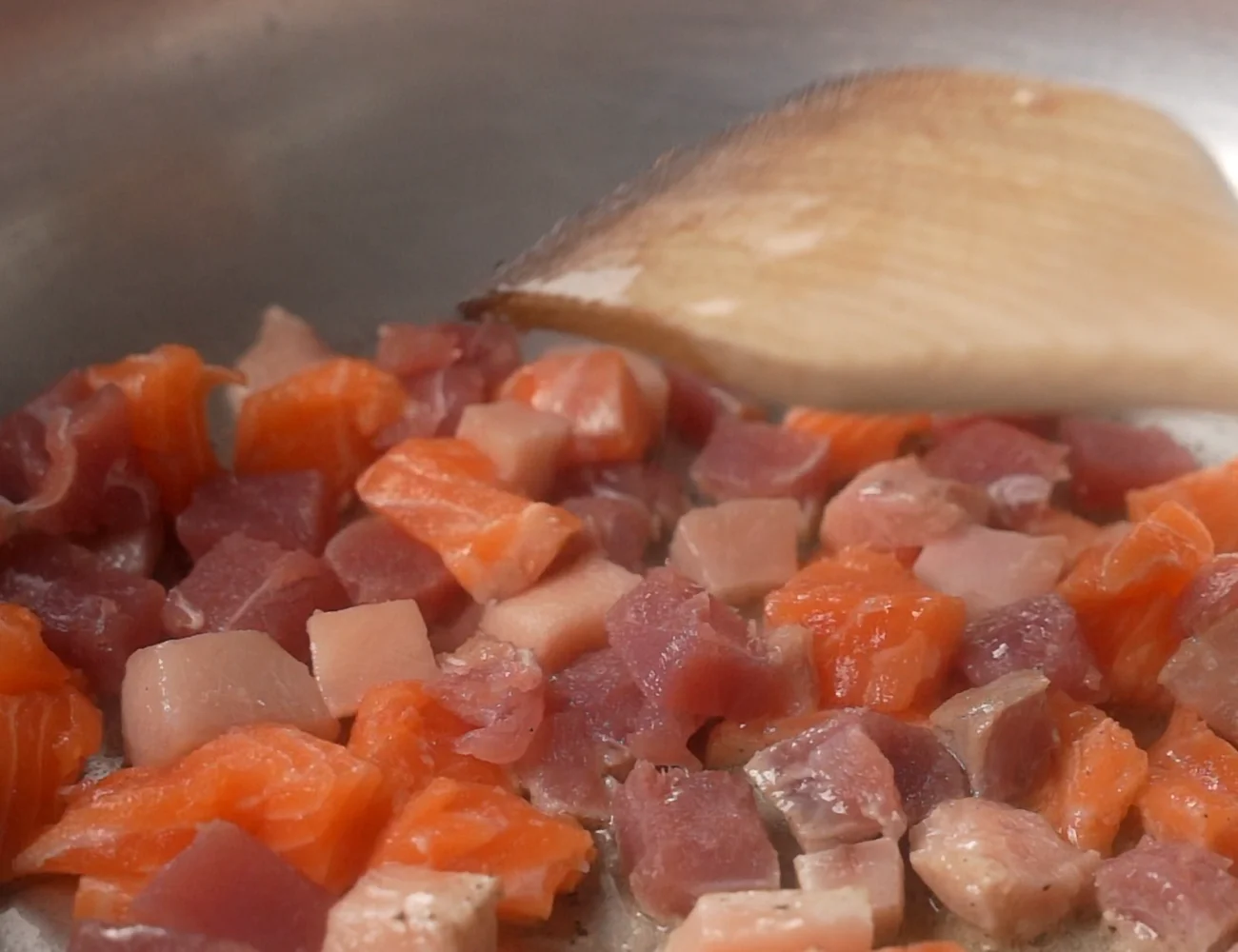
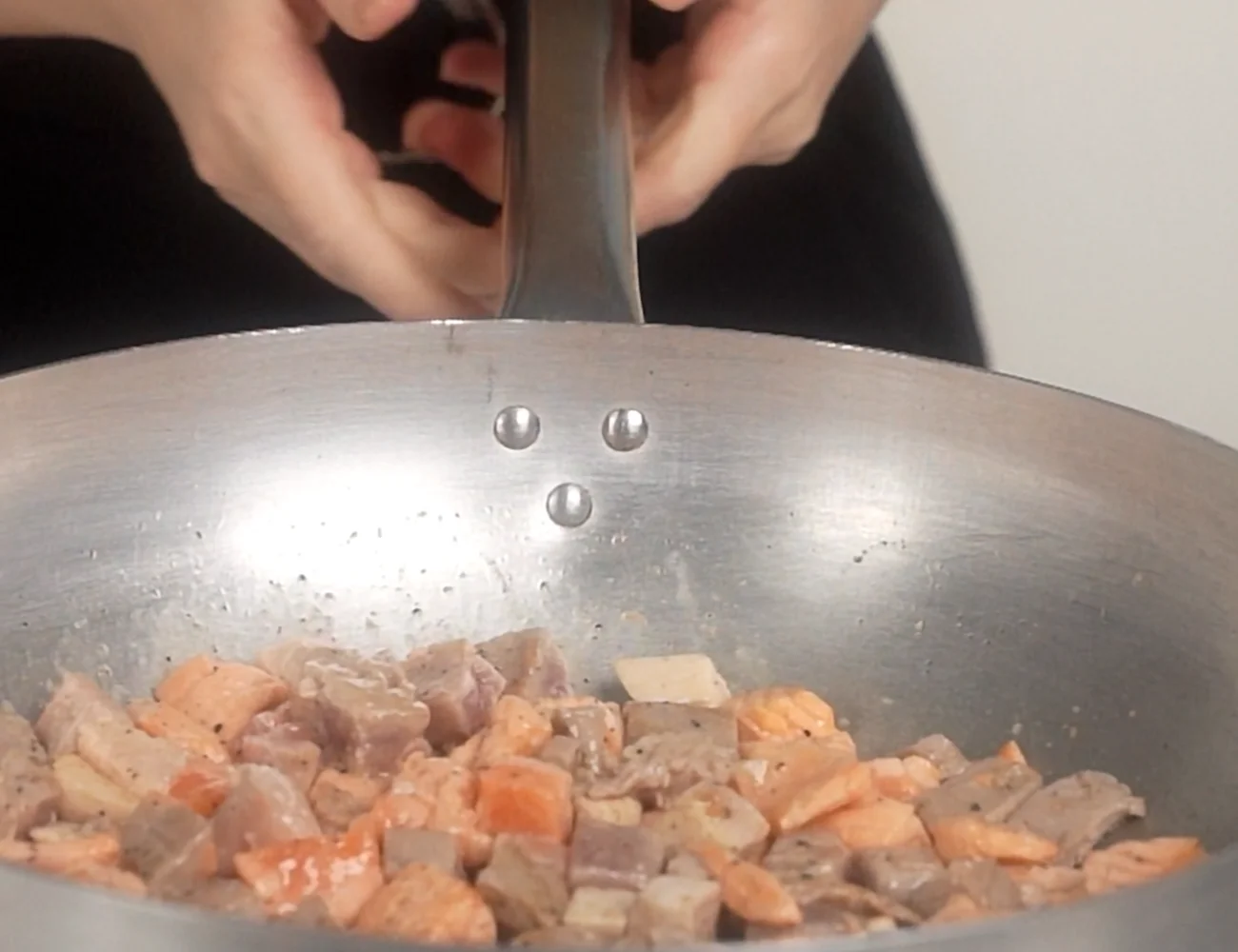
Partially Cook the Pasta
Our shellfish and broth are ready and our fish is cooked. The final pasta will come together quickly at the end, but there are a few more things we need to do: Cook the pasta and prepare the egg sauce—the ingredient that adds the ‘carbonara’ to our Seafood Carbonara recipe!
Like a traditional Carbonara, we are going to cook the spaghetti 3/4 of time recommended on the package for al dente pasta—then we’re going to finish cooking the pasta in the pan. In a traditional Spaghetti Carbonara recipe this is done to give the spaghetti time to finish off in a pepper-infused water. This time, we’re going to finish the spaghetti in a peppered shellfish broth.
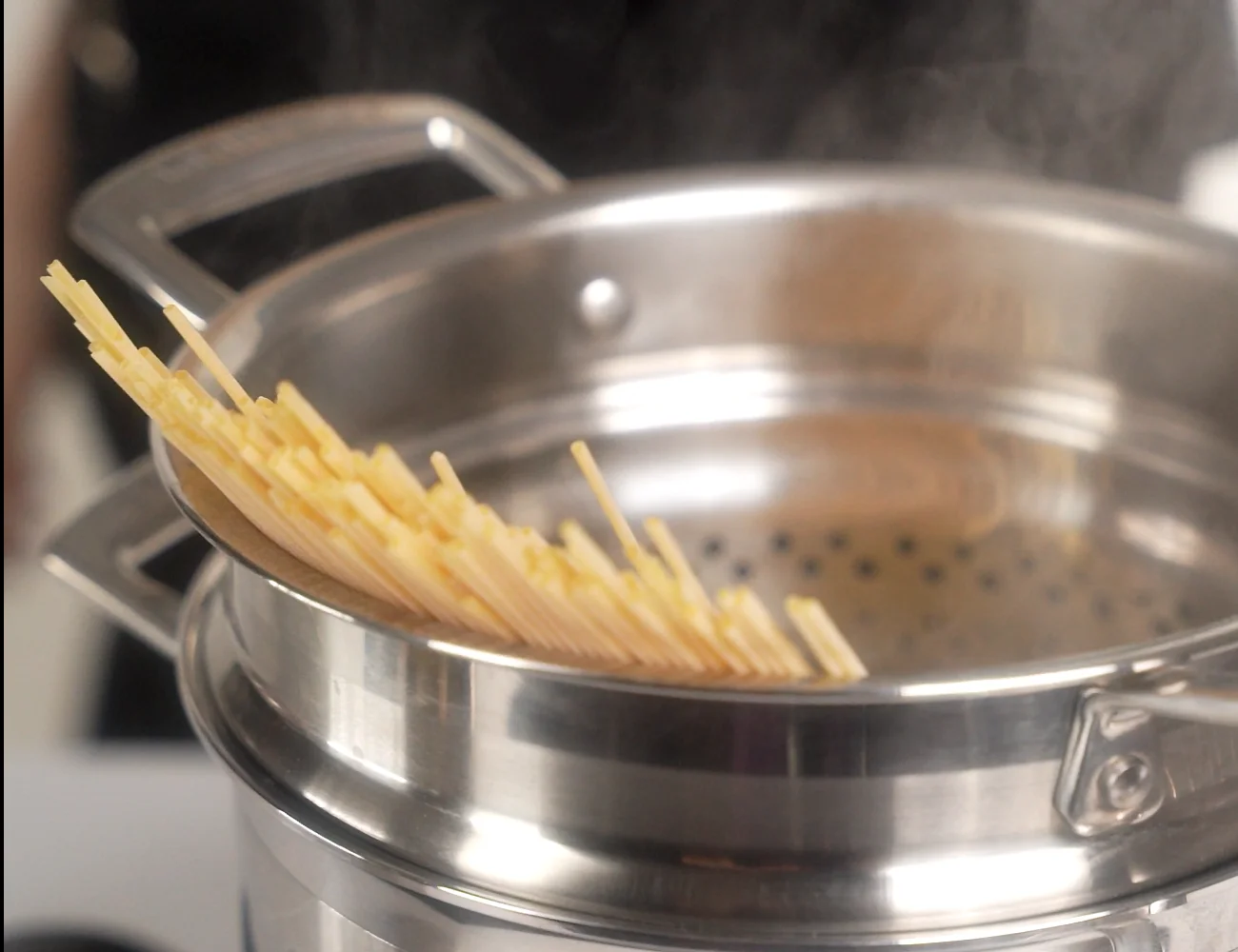
However, we are going to also use the steam from the cooking pasta to cook our egg sauce to a temperature can kill bacteria that can cause foodborne illness. This is optional. You can simply add the egg yolks raw to the pasta at the end. However, the heat from the pasta alone will not reach the temperatures need to ‘pasteurize’ the egg and maximize food safety.
Pasteurize the Carbonara Egg Sauce (Optional)
Combine a ladle of the filtered shellfish broth with the beaten egg yolks— in a bowl that can nicely sit on top of the pot in which the pasta is cooking. Choose a metal bowl (stainless steel or copper)—not glass. We want to control the heat precisely. If our egg is heating up too much, we want the temperature to quickly drop when we remove it from the heat. Glass and materials like it will retain heat, while copperware will react immediately to temperature changes.
With thermometer in hand, place the bowl with the egg sauce over the pot with the cooking pasta. We have just created a double boiler (a ‘bagno maria’ in Italian)! Whisking continuously, heat the eggs to 160°F (71°C).
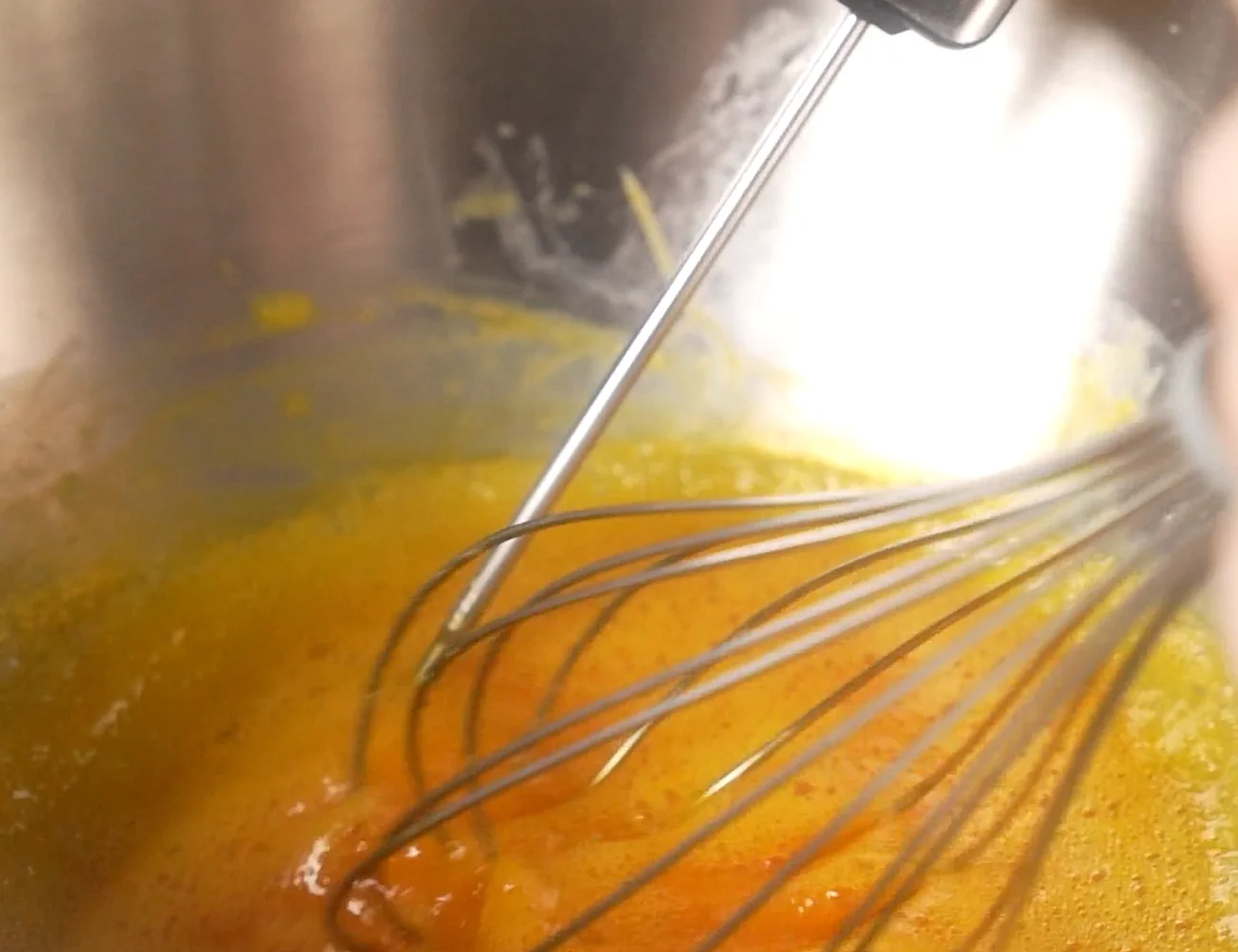
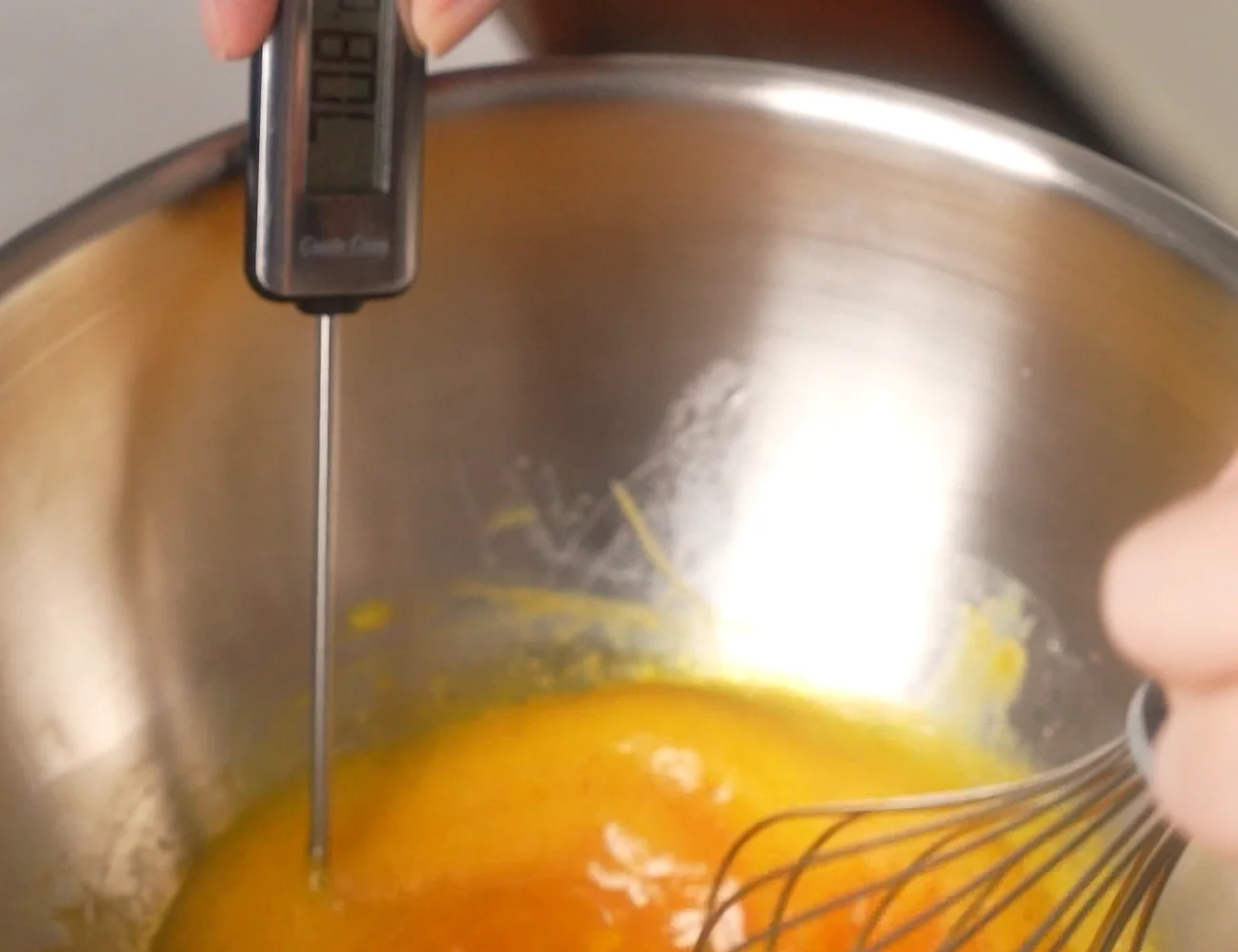
The FDA recommends pasteurizing egg yolks at home by heating them to a temperature of 160°F (71°C). This temperature is sufficient to kill harmful bacteria like Salmonella, making the egg yolks safe for consumption, especially in recipes where they won't be cooked, such as in homemade mayonnaise or certain sauces.
Won’t the eggs coagulate at this high temperature?
Egg yolks typically begin to coagulate at temperatures around 149°F to 158°F (65°C to 70°C). However, reaching the FDA-recommended pasteurization temperature of 160°F (71°C) for safety does not necessarily mean that the yolks will instantly or completely solidify at this point. The coagulation process is gradual and can be influenced by factors like the egg’s pH level and the presence of other ingredients, like sugar or salt, which can raise the coagulation temperature.
When pasteurizing egg yolks at home, it’s important to heat them gently and stir continuously to avoid scrambling. The goal is to reach the target temperature to ensure safety, while maintaining a consistency that is suitable for your recipe. Using a double boiler and a food thermometer can help manage this process effectively, as we’ve recommended.
Strain the Egg Carbonara Sauce
After the eggs have reached the desired temperature, strain it. Straining will remove any bits of egg that have started to coagulate during the cooking process, leaving you with a creamy, dreamy sauce. Yes, this same process can be used to pasteurize the eggs at home for a traditional Spaghetti Carbonara recipe! In that case, treat the whisked (cooked) egg just as you would the raw egg, whisking in the finely grated cheese and adding this sauce to the cooked pasta off the heat.
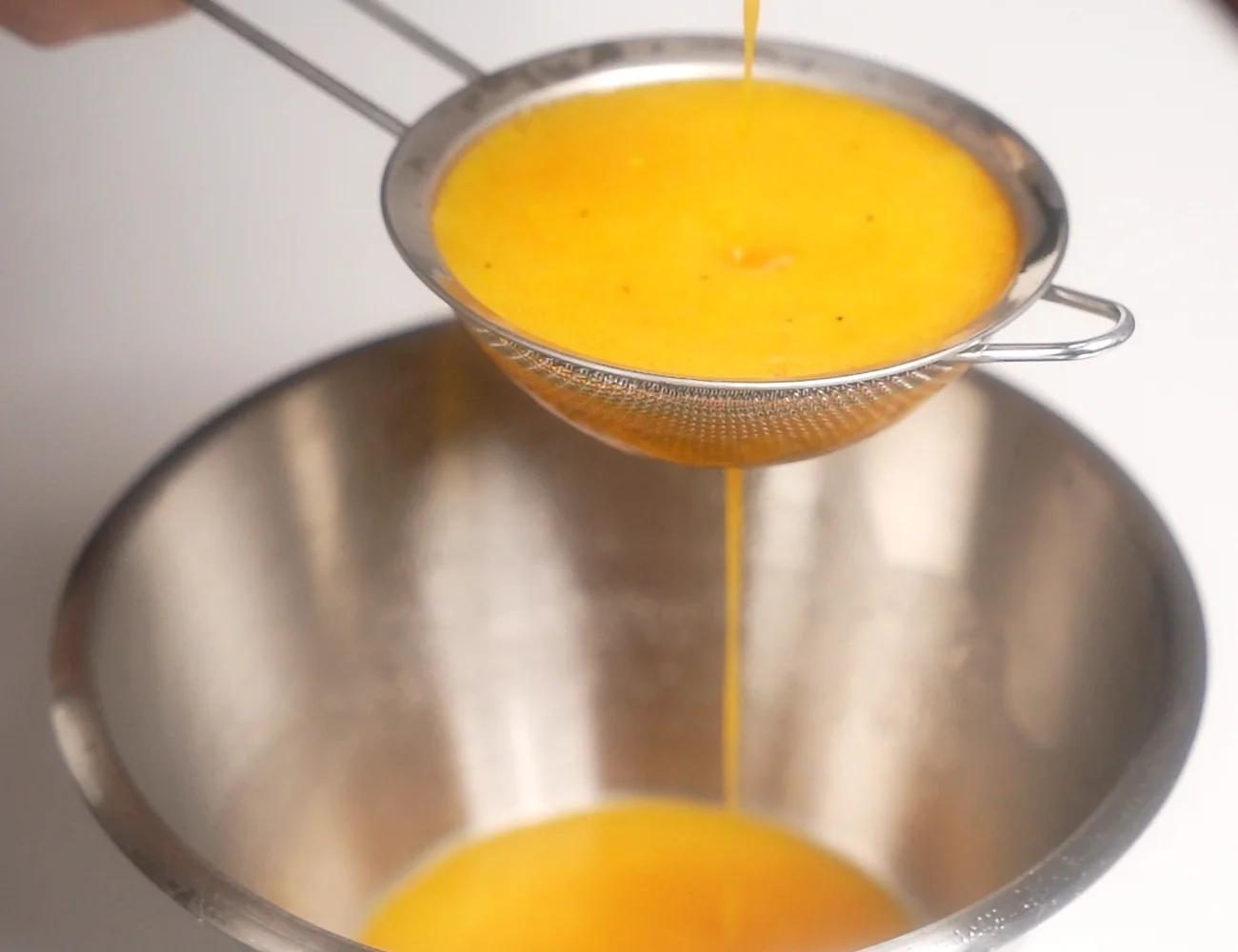
Finish the Pasta in the Sauce
As the pasta finishes partially cooking, reheat the shellfish, broth and fish in the skillet.
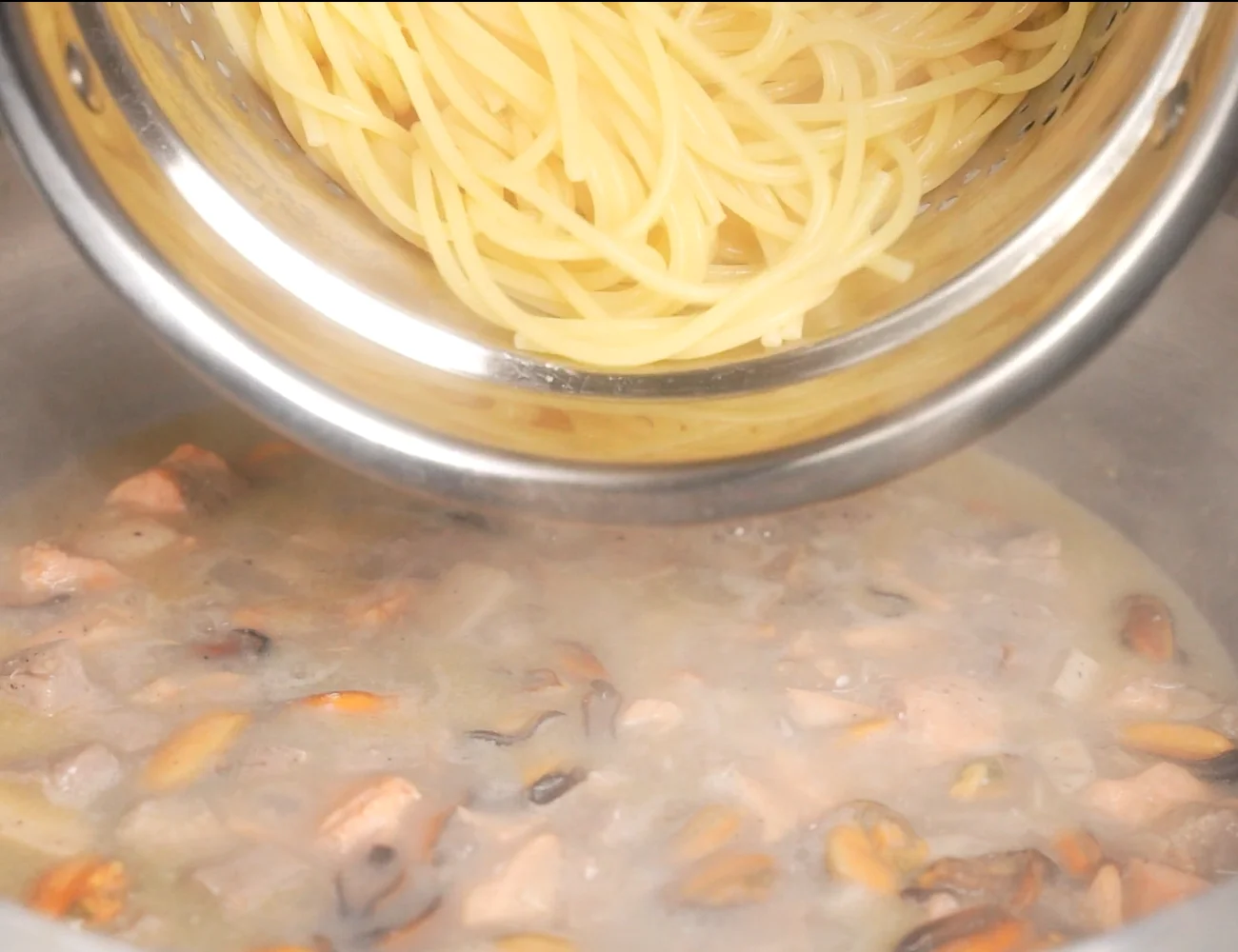
Then, add the pasta and finish cooking it in the pan along with any shrimp you want to add (optional).
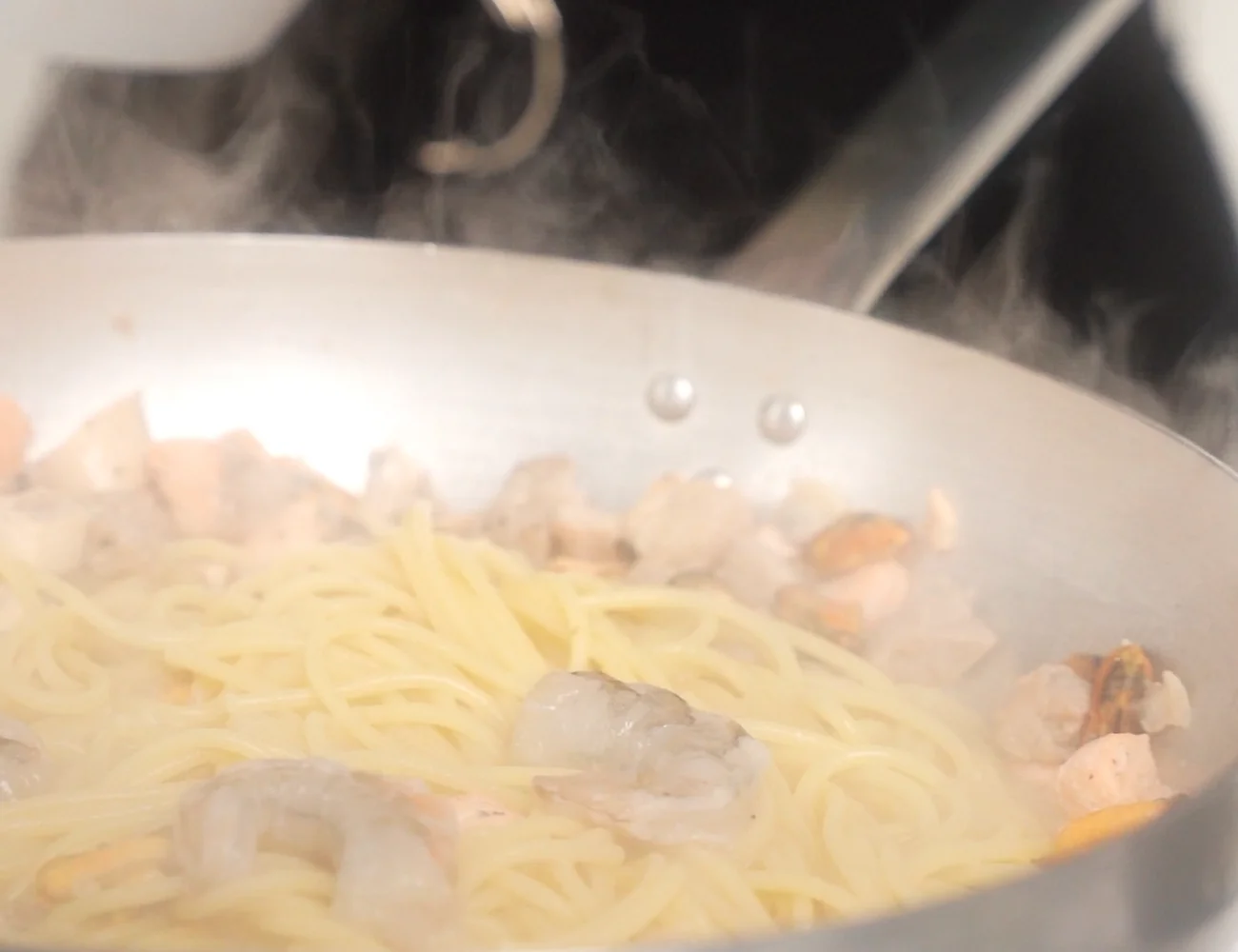
Add the Egg Sauce
When the pasta is cooked, remove it from the heat and stir in the egg carbonara sauce.
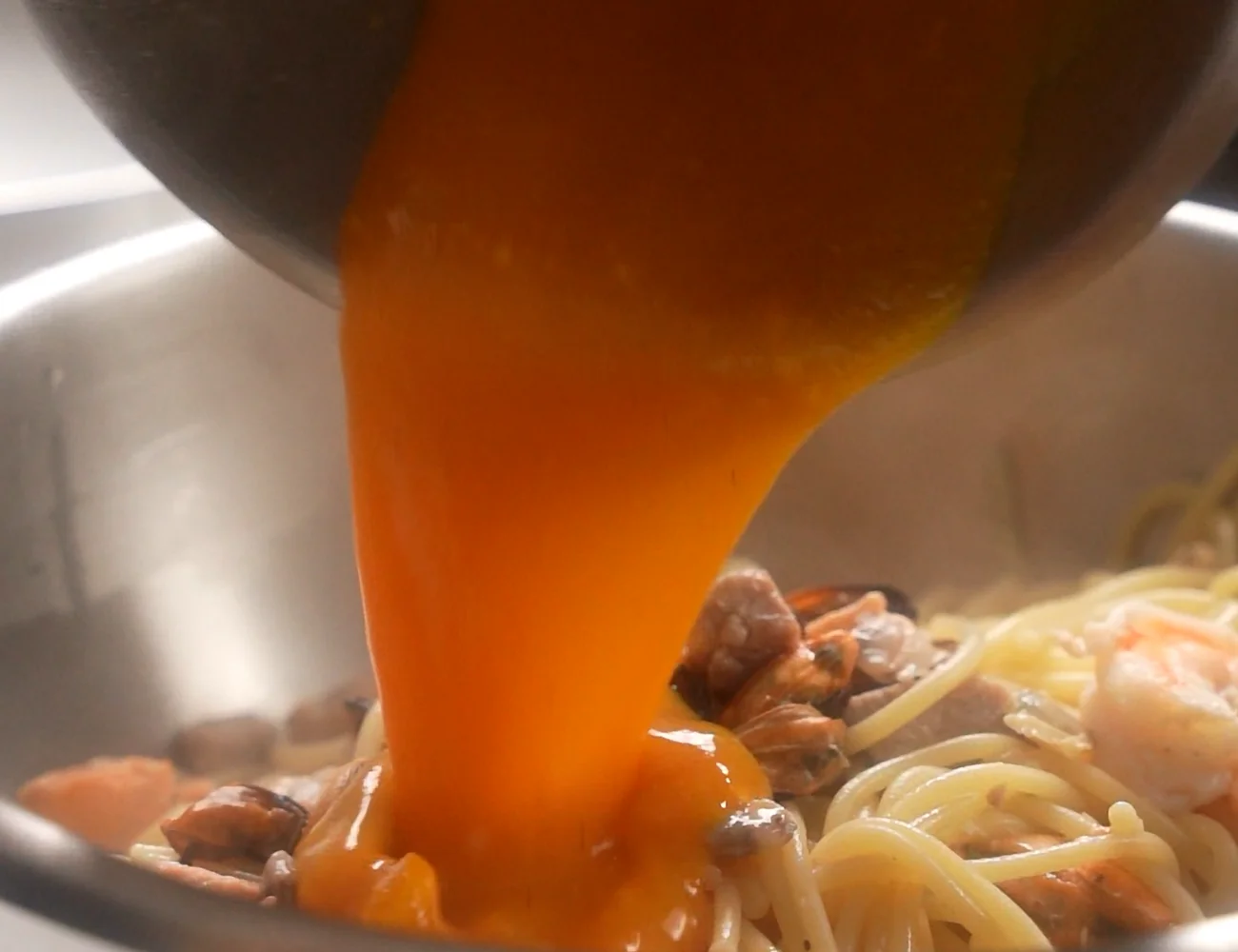
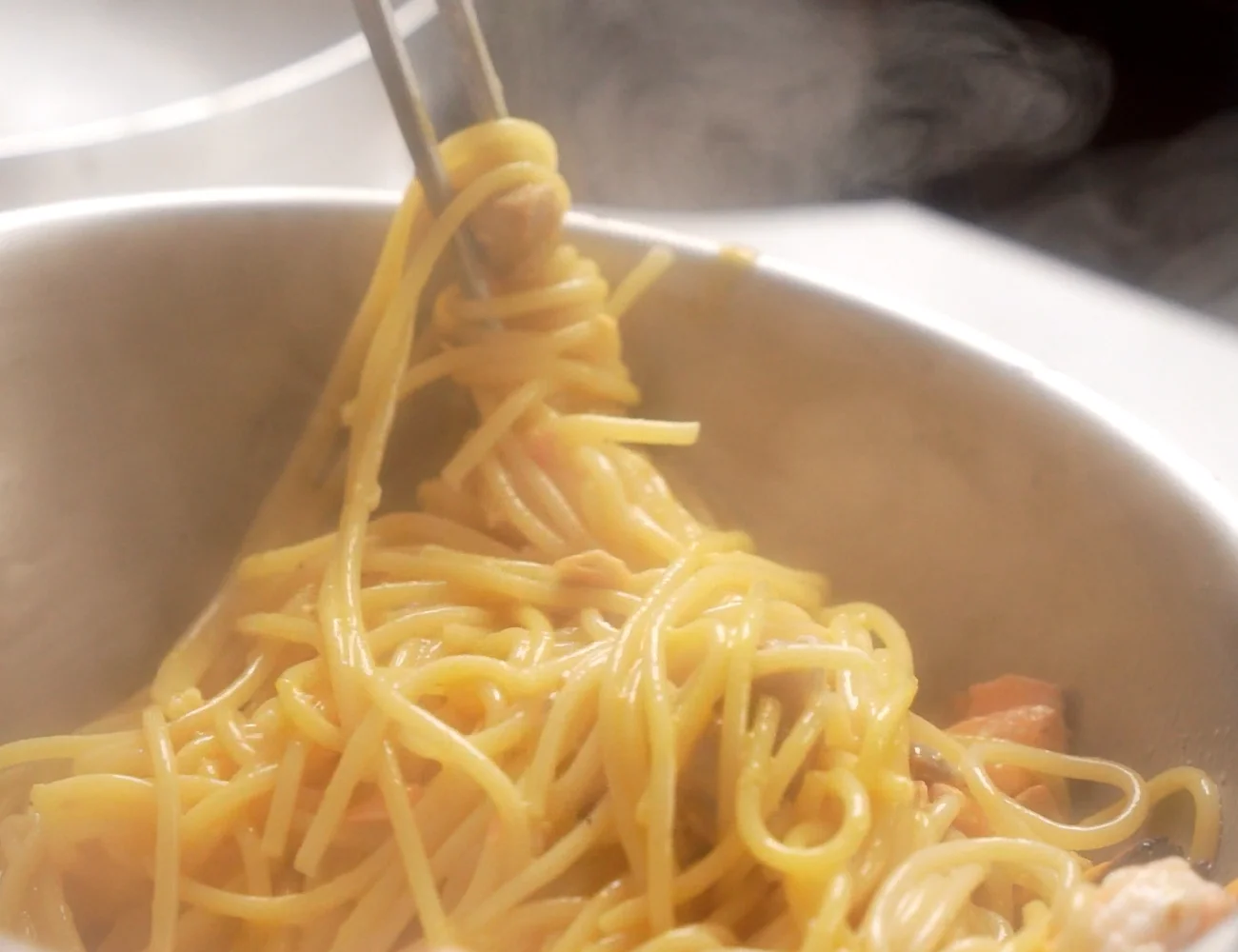
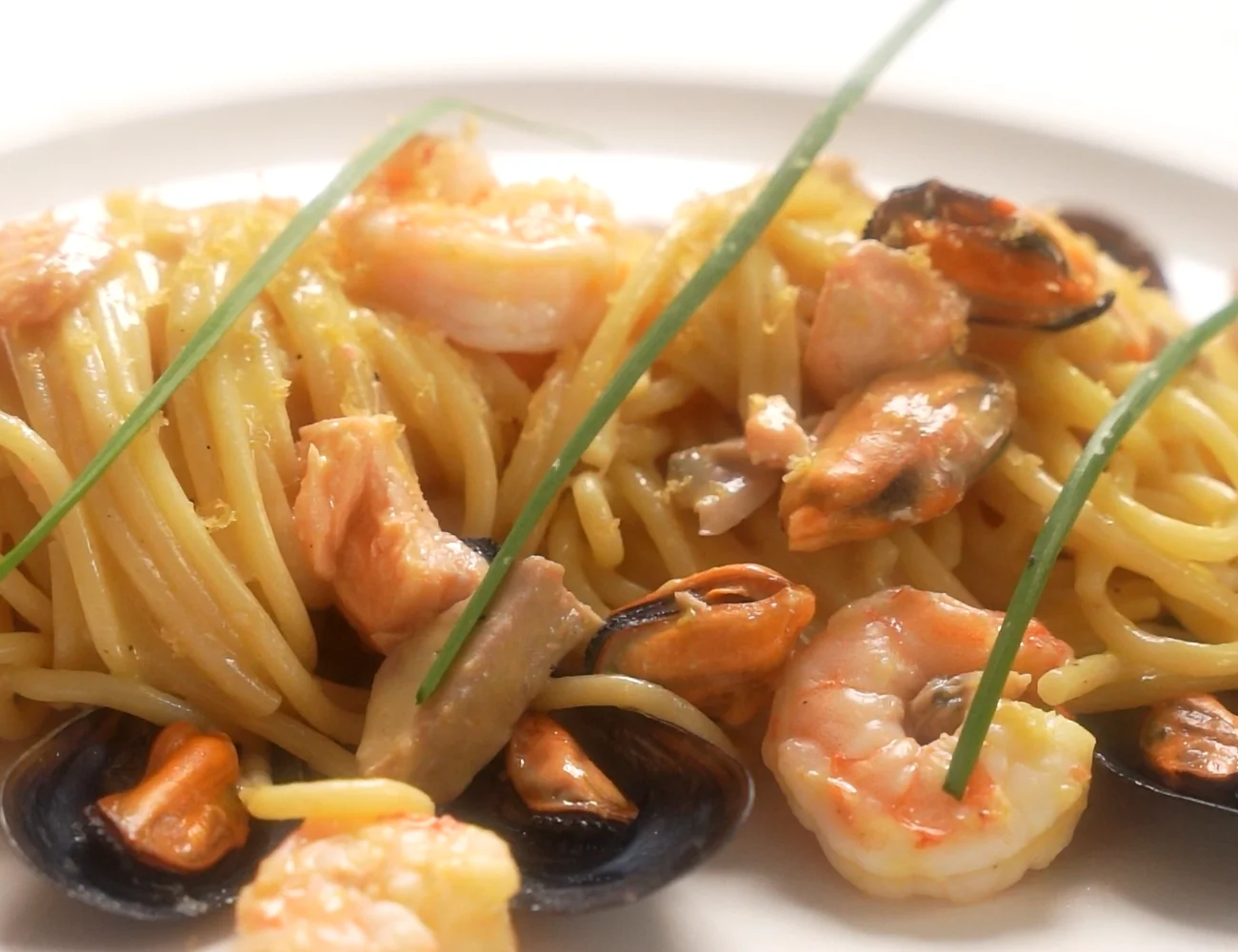
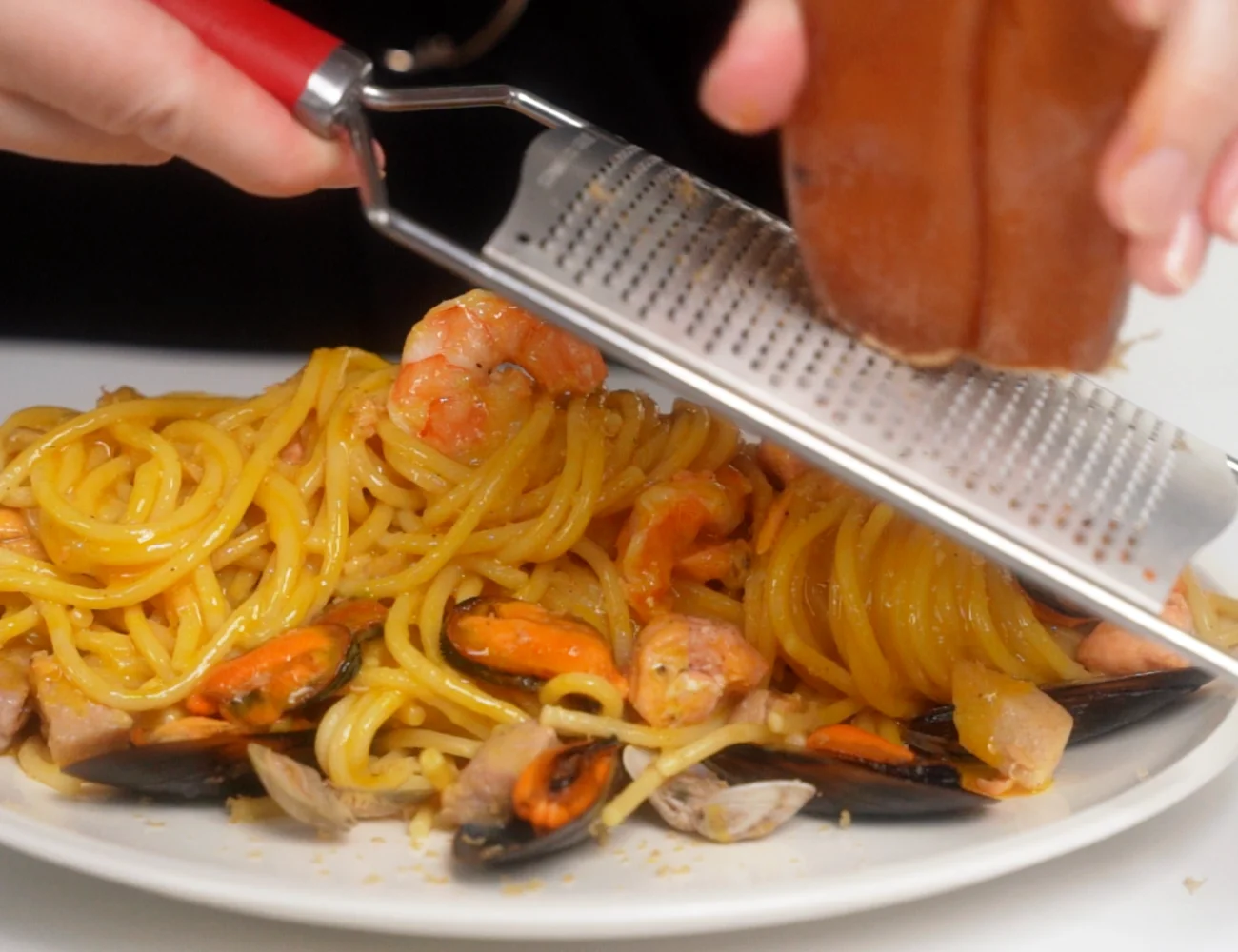
Products We Use in the Video (or Recommend)
Amazon Affiliate links:
Other Affiliate links:
Learn more about why we think this knife is one of the best all-purpose kitchen knives in our guide!
We are affiliates of Nakano and receive a small commission if a purchase is made using our links or discount codes. That said, we only choose accept affiliate partnerships with products we use or believe in.
As an Amazon Associate, we earn from qualifying purchases. This means at no extra cost to you, PIATTO may earn a small commission if you click the links and make a qualifying purchase.
More Authentic Italian Pasta Recipes!
Seafood Carbonara Recipe (Carbonara di Mare)
Equipment
- 1 Large Pot for cooking the pasta
- 1 bowl to fit over the pot to create a double boiler
- 1 whisk
- 1 thermometer kitchen
- 1 large pan or skillet
Ingredients
- 2.2 lbs mussels beards removed
- 1 lb clams
- 2 ½ oz salmon filet
- 2 ½ oz tuna filet
- 2 ½ oz swordfish filet
- 4 shrimp optional
- 6 egg yolks
- 2 tbsp olive oil
- 3 cloves fresh garlic
- 1 tbsp butter
- 1 tbsp black pepper coarsely grated
- 1 pinch fine salt
- 11 oz spaghetti we used 'spaghetti grosso'
- bottarga optional, for grating on top
For Soaking the Clams to Remove the Sand
- 2 tbsp salt
- 4 cups water
Instructions
Prepare the Clams
- Prepare a salt bath for the clams using 2 tbsp for every 4 cups of water. Submerge a strainer in the water. Add the fresh clams to the strainer in the salt water.2 tbsp salt, 4 cups water
- Let the clams soak for 2 hours. During this time they will exchange the water (with sand) inside their shells for the fresh salt water. The sand will fall to the bottom of the soaking bowl.1 lb clams

- After the two hours, remove the clams from the salt water bath with the strainer and set aside. Discard the (now sandy) water bath.

Prepare the Mussels
- Give the mussels a rinse and scrape off any debris. Remove the 'beard' of the mussels by pulling down and out towards the wider side of the mussel.2.2 lbs mussels

Prepare the Eggs
- Separate the eggs, saving just the yolks for the sauce. Use a bowl that can comfortably fit over a the pot where you will boil the pasta. We will be creating a double boiler as the pasta cooks with the boiling pasta water to pre-cook the egg sauce to the temperature recommended by the FDA for egg food safety.6 egg yolks
Steam the Shellfish
- Sauté the garlic in the olive oil in a large pan over medium heat.2 tbsp olive oil, 3 cloves fresh garlic

- Add the mussels and clams to the pan. Cover and cook over medium heat until most of the shells have opened. Discard any shellfish with unopened shells (they aren't safe to eat).

- Strain the broth using a sieve or cheesecloth to remove any remaining sand. Save the broth for later.

- Remove all or most of the shellfish meat from the shells and let them soak in the strained broth until it is time to use them. You can leave a few shellfish in the shell for plating and decoration if you like.

Cook the Fish
- Remove any skin or bones from the fish filets. Then dice the fish.2 ½ oz salmon filet, 2 ½ oz tuna filet, 2 ½ oz swordfish filet

- Briefly toast black pepper over low heat in a dry pan, just until it gives off a fragrance. Set the pepper aside.1 tbsp black pepper

- Melt the butter in the pan, add the pieces of fish. Cook the fish over medium heat for a few minute—it doesn't take long to cook small pieces of fish. Salt to taste and set the cooked fish aside.1 tbsp butter, 1 pinch fine salt

Partially Cook the Pasta
- While the fish is cooking, bring a pot of unsalted boiling water to a boil. Cook the spaghetti in the boiling water for ¾ of the time listed on the package instructions for al dente pasta. You can add a bit of salt to the water if you like—but very little. We will be using the salty shellfish broth to finish cooking the pasta and we don't want the pasta to be too salty.11 oz spaghetti

Cook the Egg Sauce (the Carbonara Sauce)
- To pre-cook the carbonara egg sauce, we can use the hot water from the cooking pasta as a water bath to make a double boiler.
- To pre-cook the egg sauce, whisk together the egg yolks with about a ladle of the shellfish broth. Then, place the bowl with the egg sauce over the pot of hot water. Using a thermometer to control the temperature of the egg sauce and whisking continuously, heat the egg yolk sauce over the double boiler to 160℉ (71℃). This is the temperature the FDA recommends to kill off most bacteria in eggs which can cause foodborne illness.

- When the egg sauce has reached this temperature, remove it from the heat and keep whisking to cool it quickly.

- Strain the egg sauce to remove any clumps. Eggs will start to coagulate at the temperature required for egg safety, but by whisking continuously and straining you can remove any small clumps that have started to form. The result? A creamy and velvety sauce perfect for Carbonara lovers who want to avoid the risks of raw egg.

Finish Cooking the Pasta
- Combine the shellfish, shellfish broth and fish in the large pan. Heat the sauce then…

- Add the partially cooked pasta—and shrimp if you are adding it. Finish cooking the pasta to al dente in the shellfish broth.4 shrimp

- Remove the cooked pasta from the heat. Add the pre-cooked egg sauce and stir quickly to combine. The heat from the pasta will warm the egg sauce.

- Serve immediately and top with grated bottarga for an extra punch of umami.bottarga

- Buon appetito 🙂


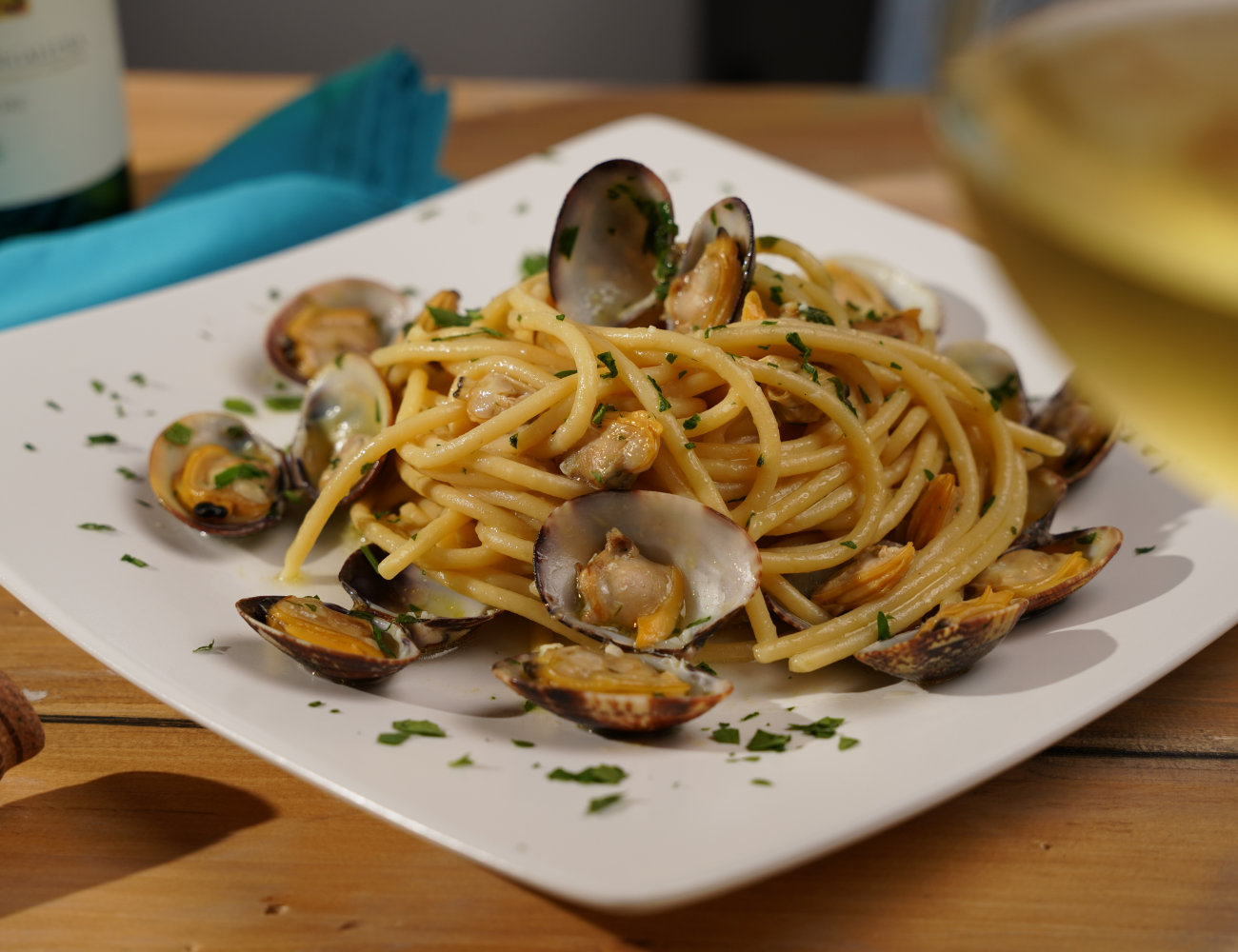
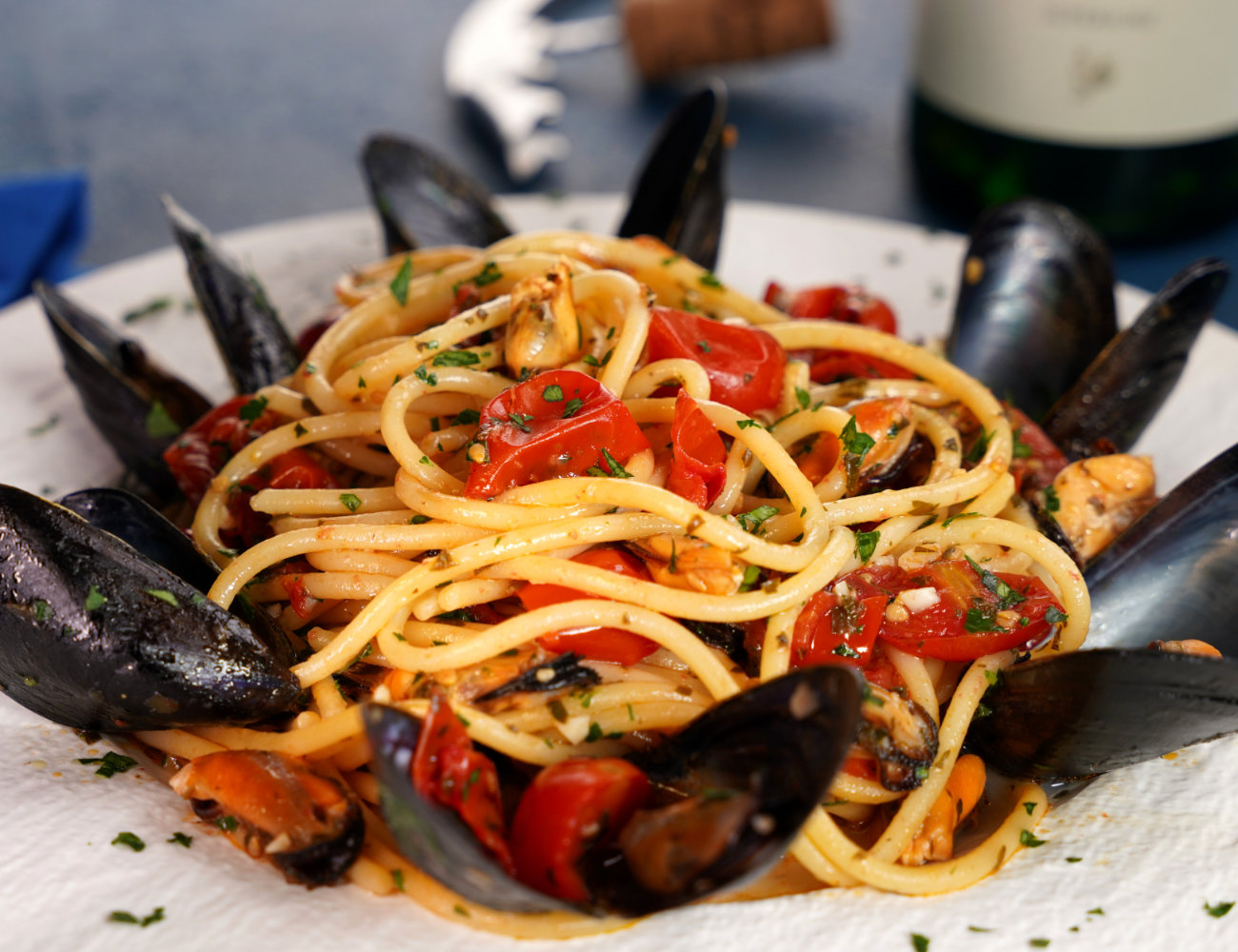
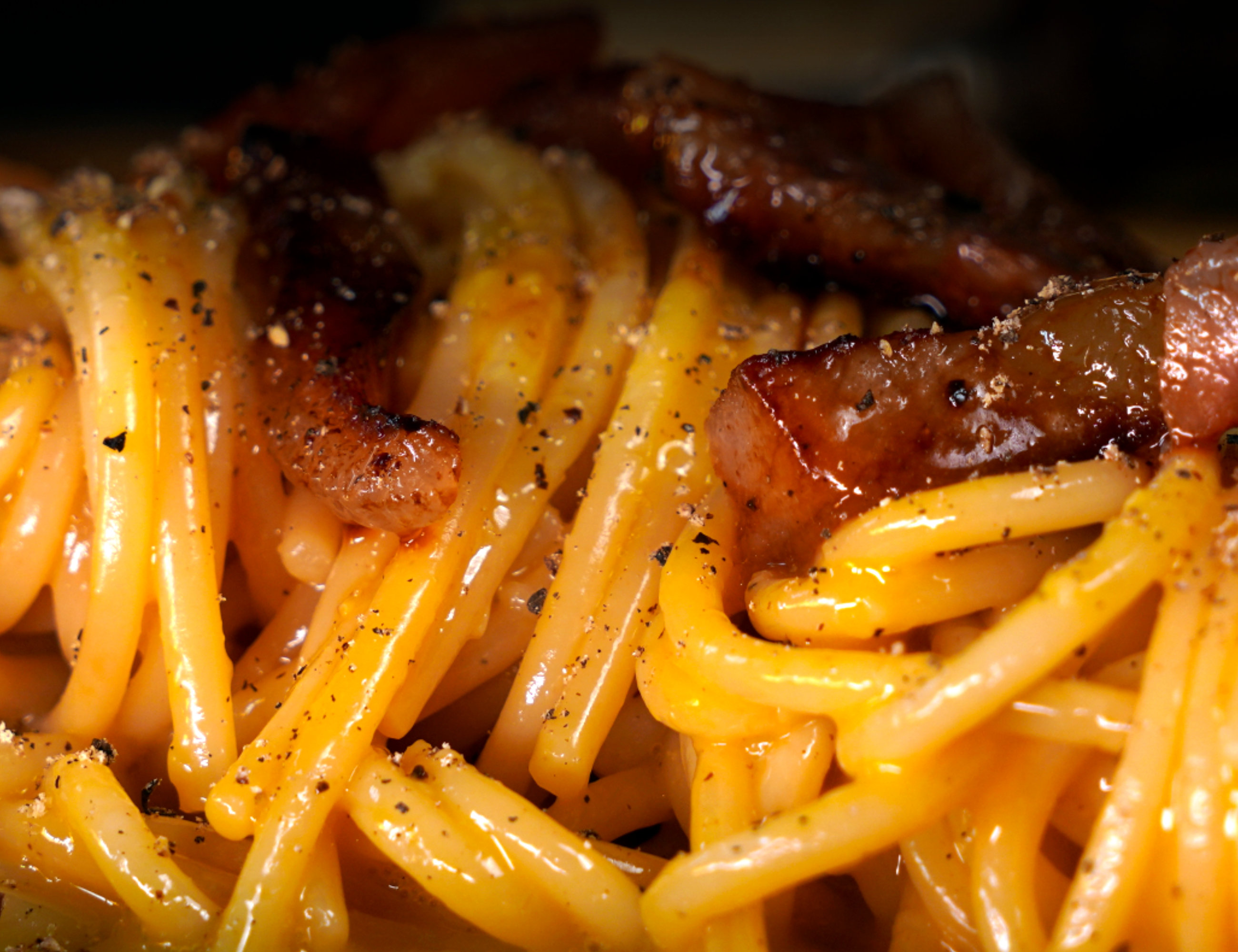
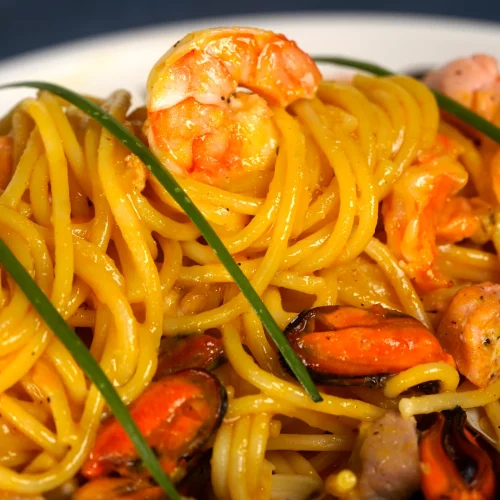
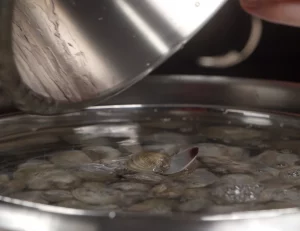
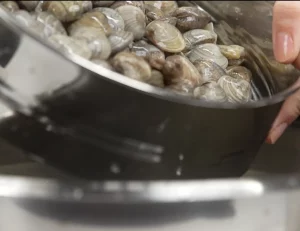
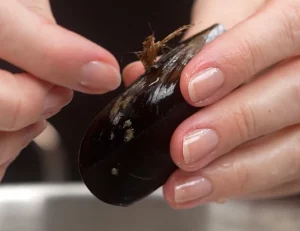
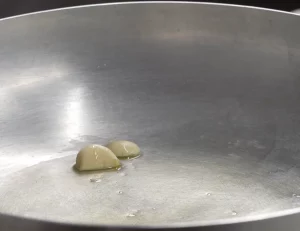
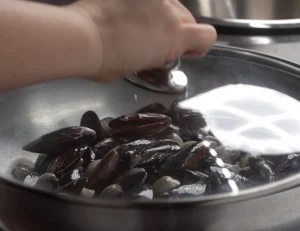
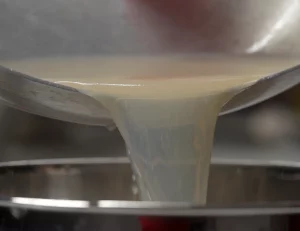
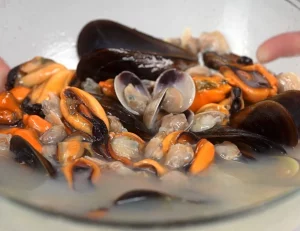
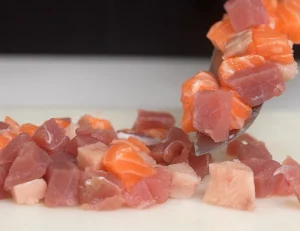
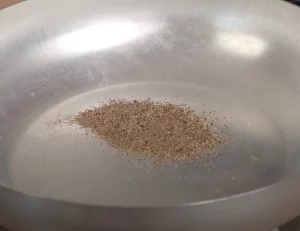
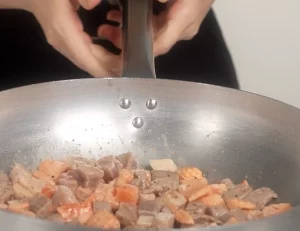
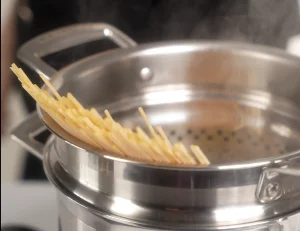
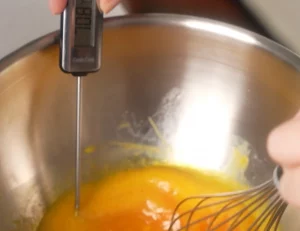
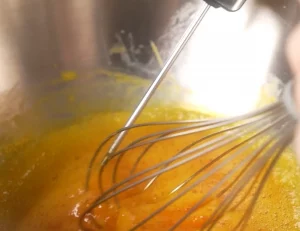
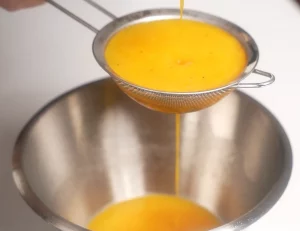
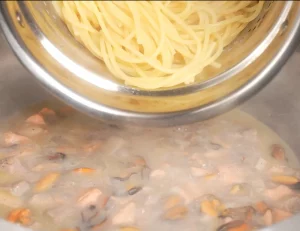
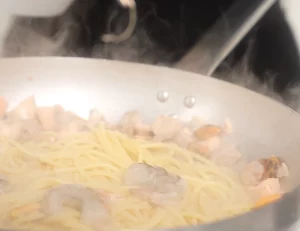
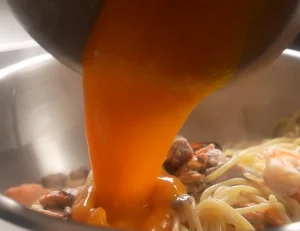
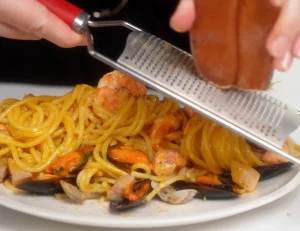
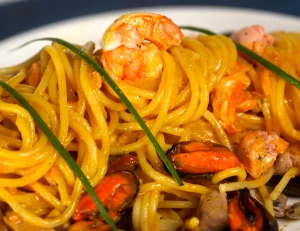

This recipe has exactly 7 sea foods! Perfect for la Vigilia. Plus, love the cooked egg sauce tutorial 🙂